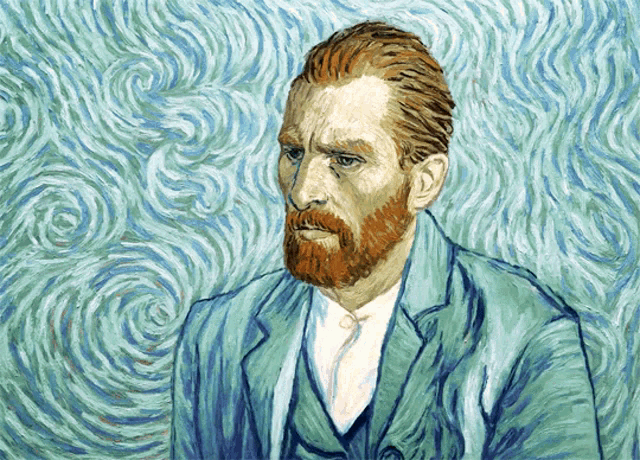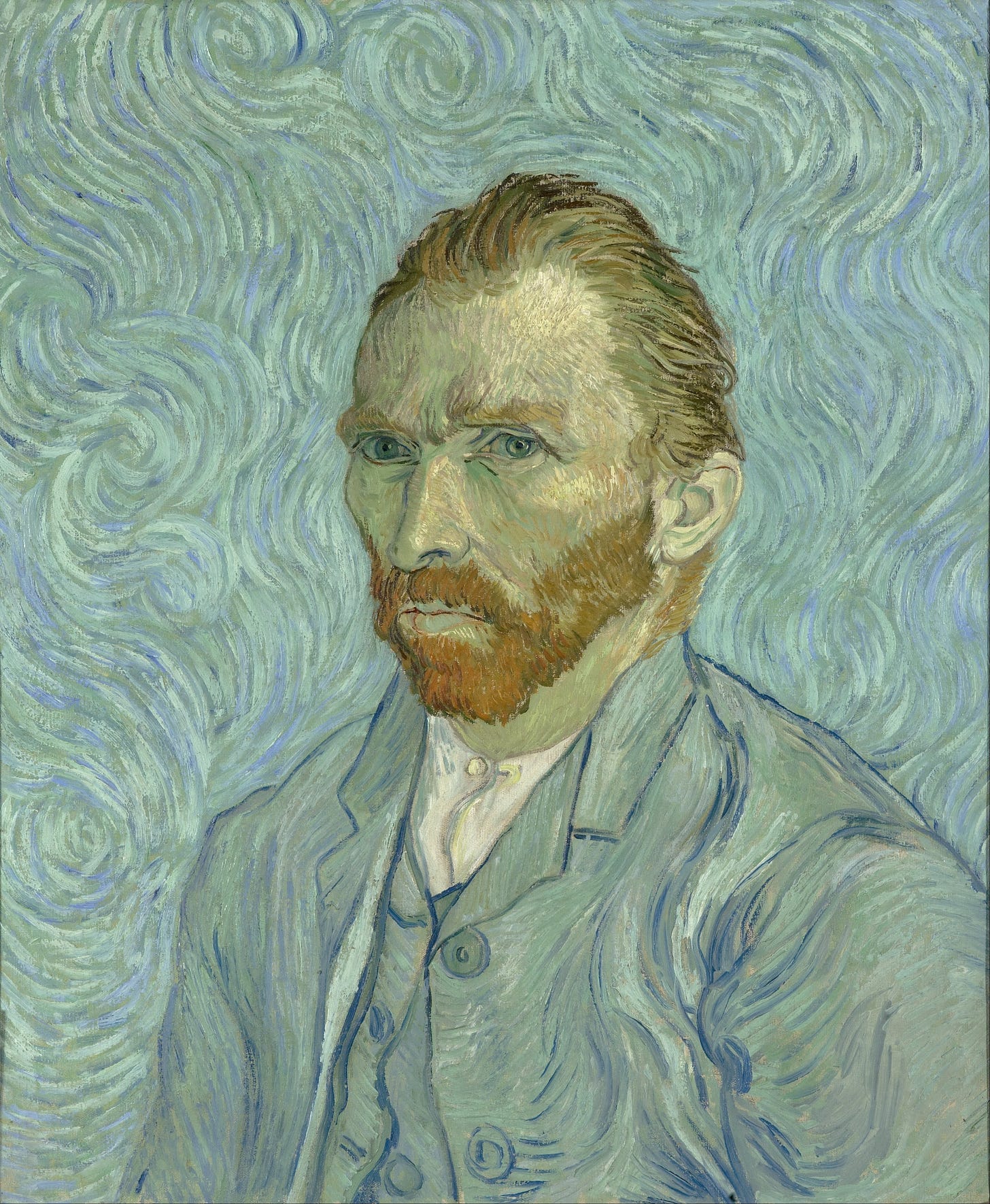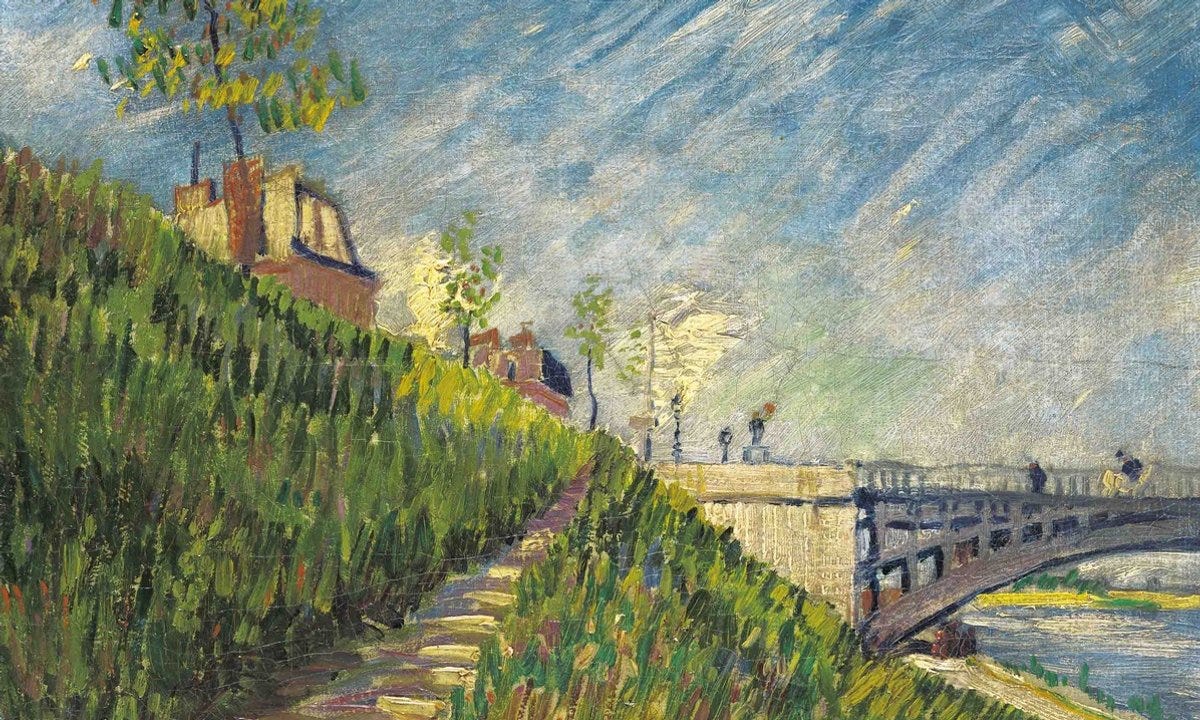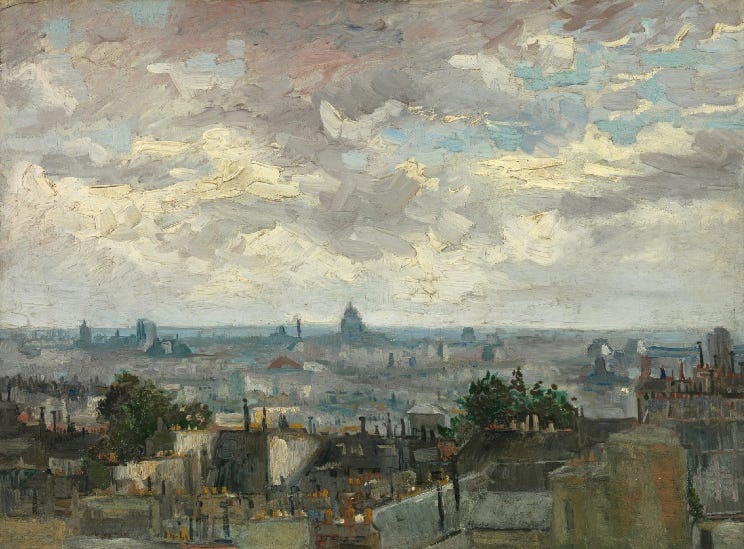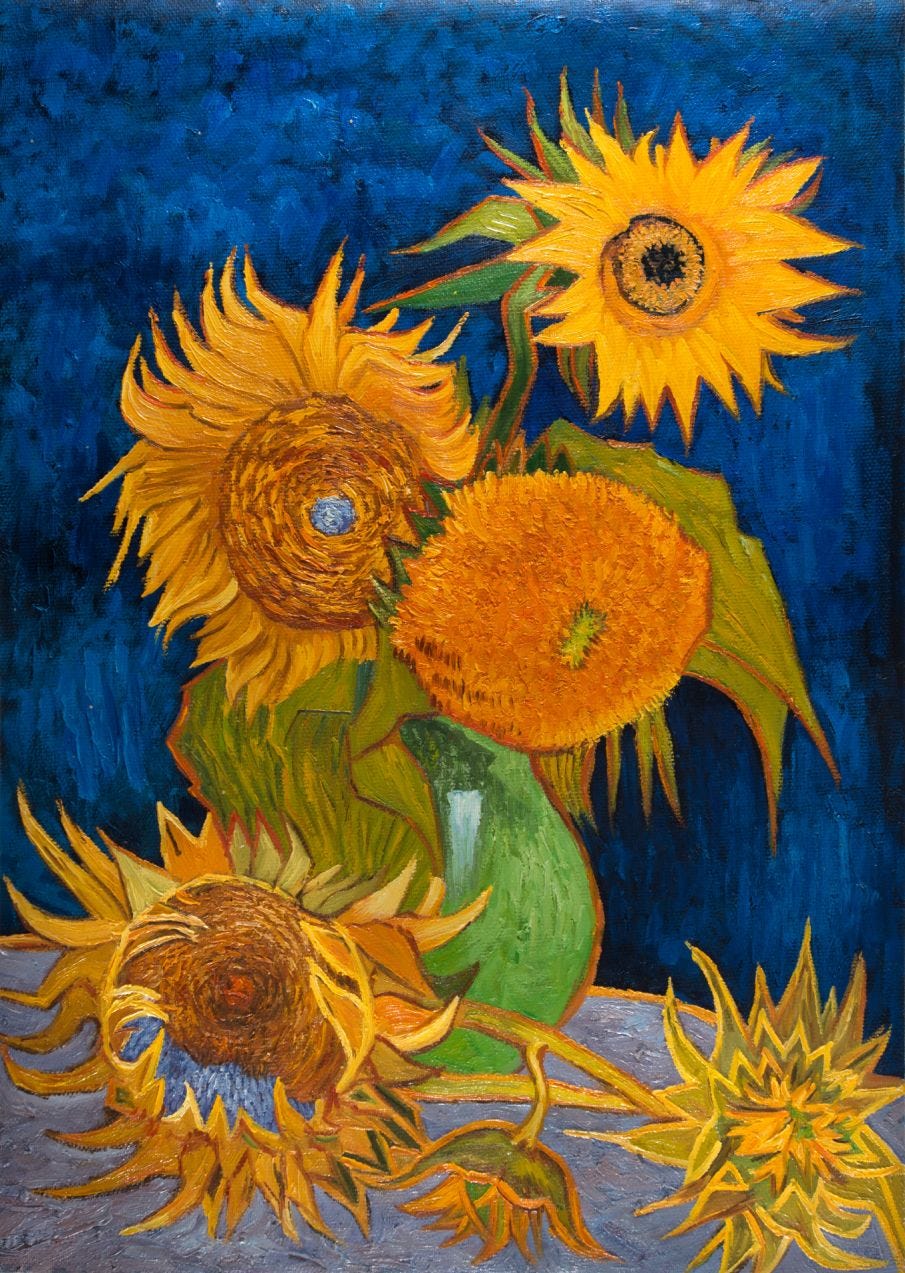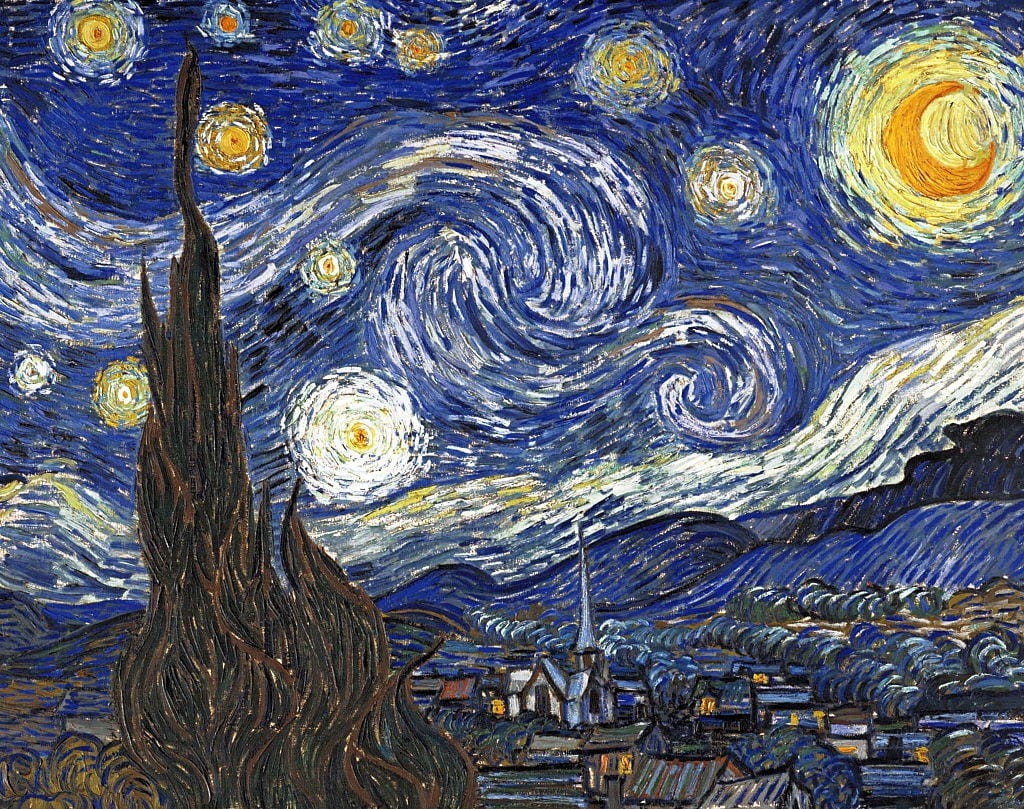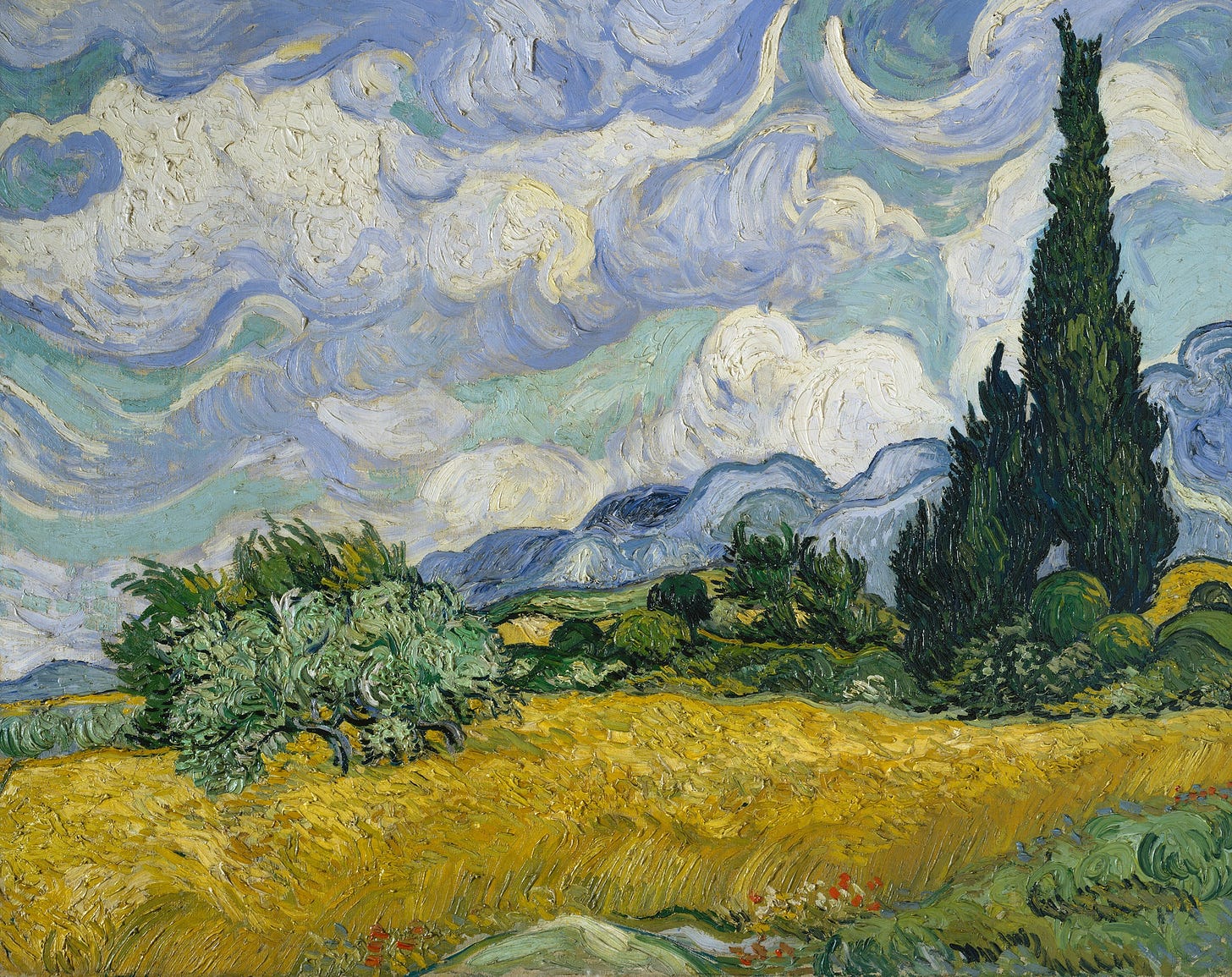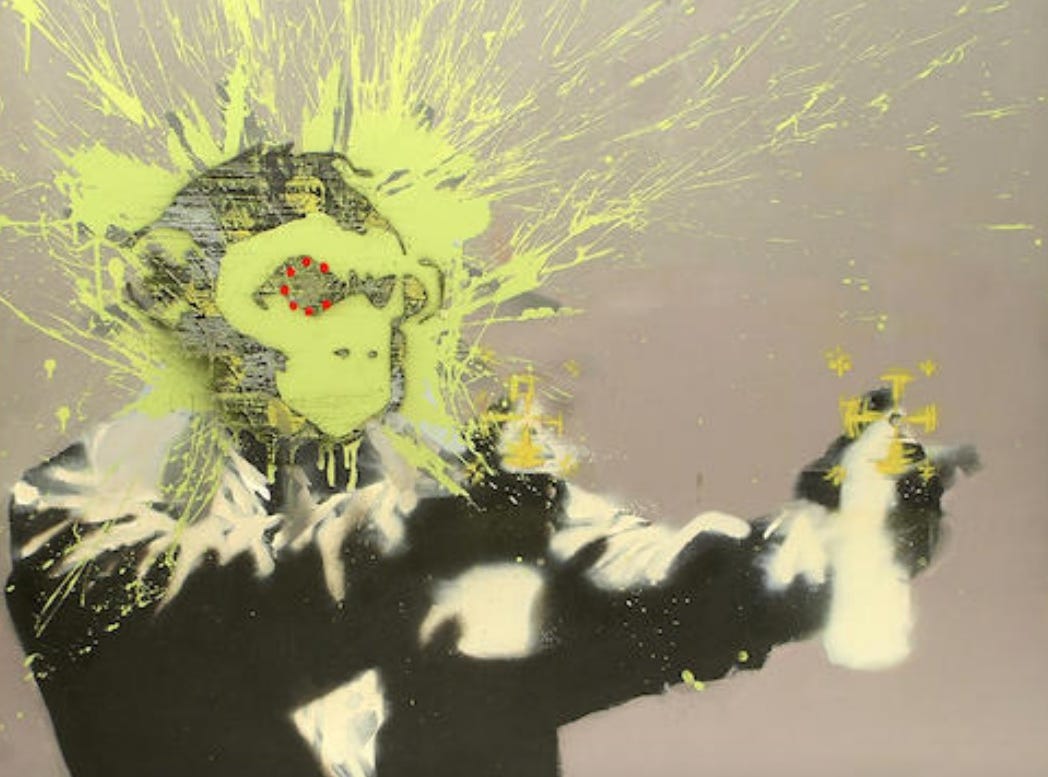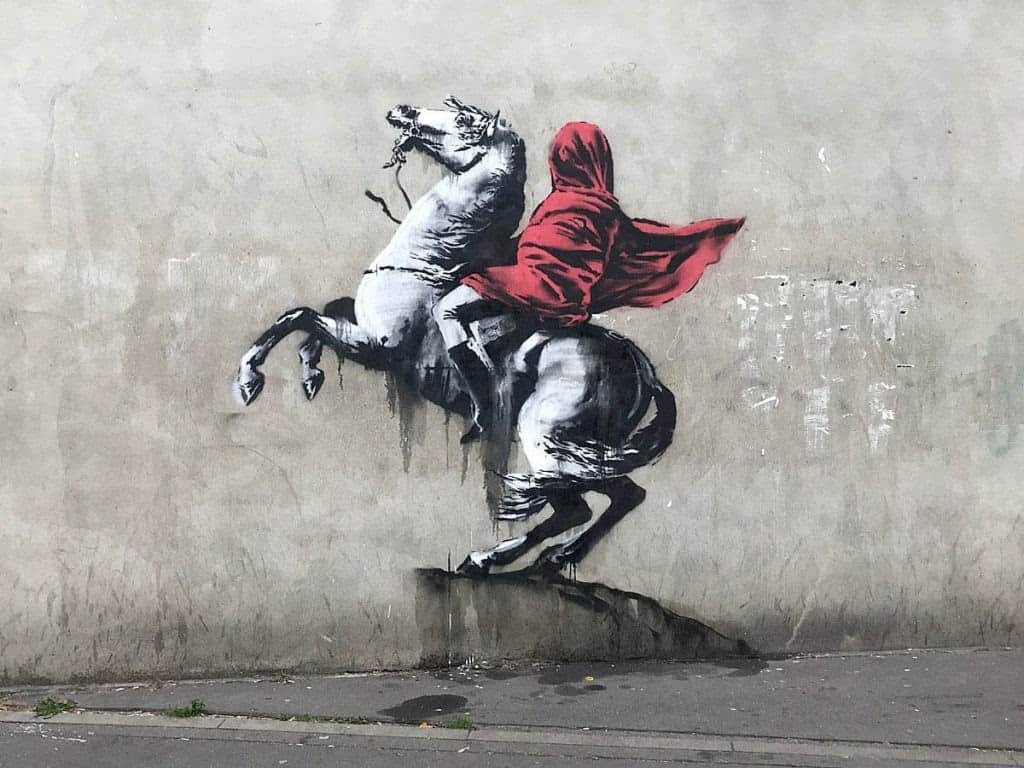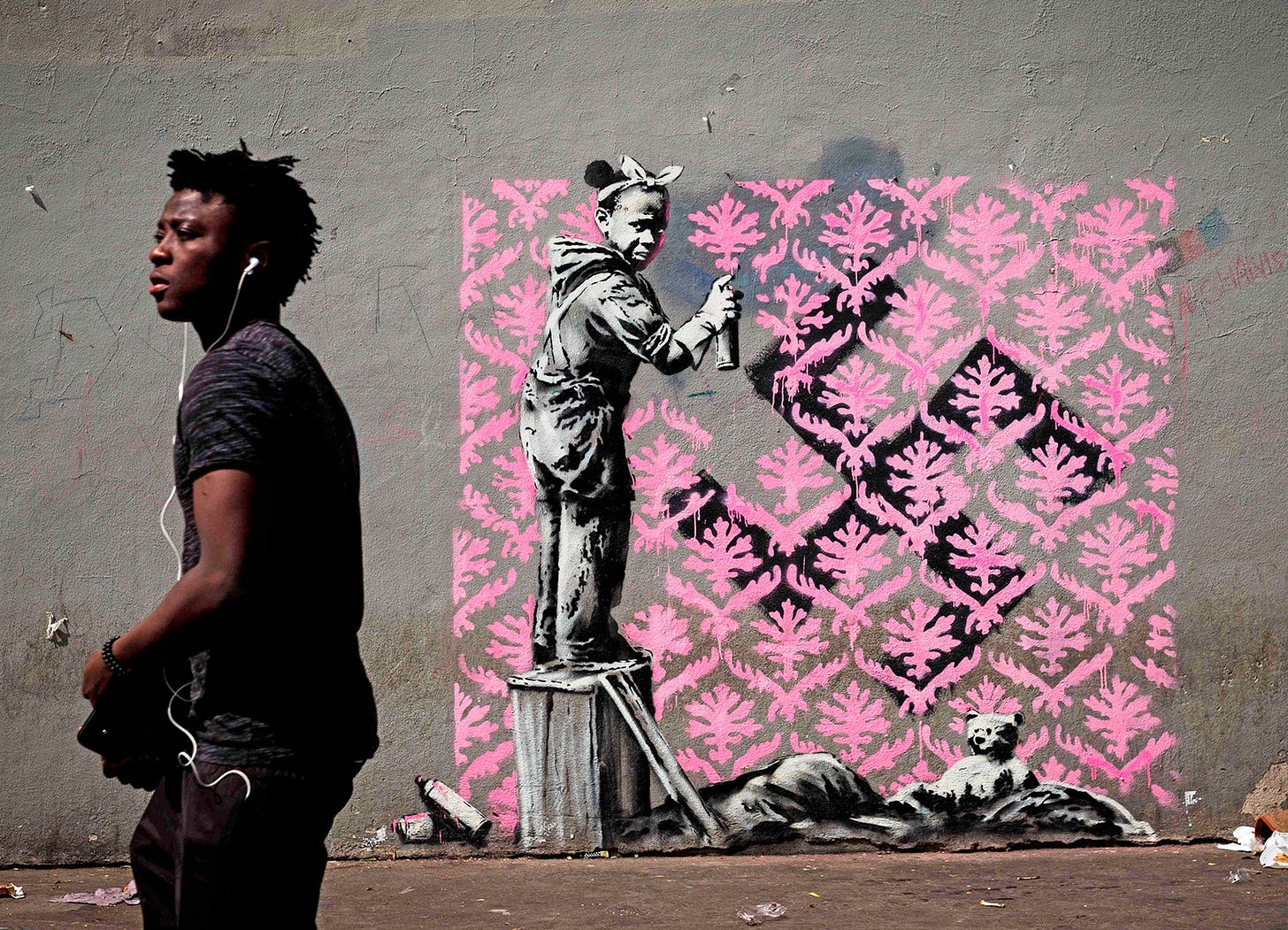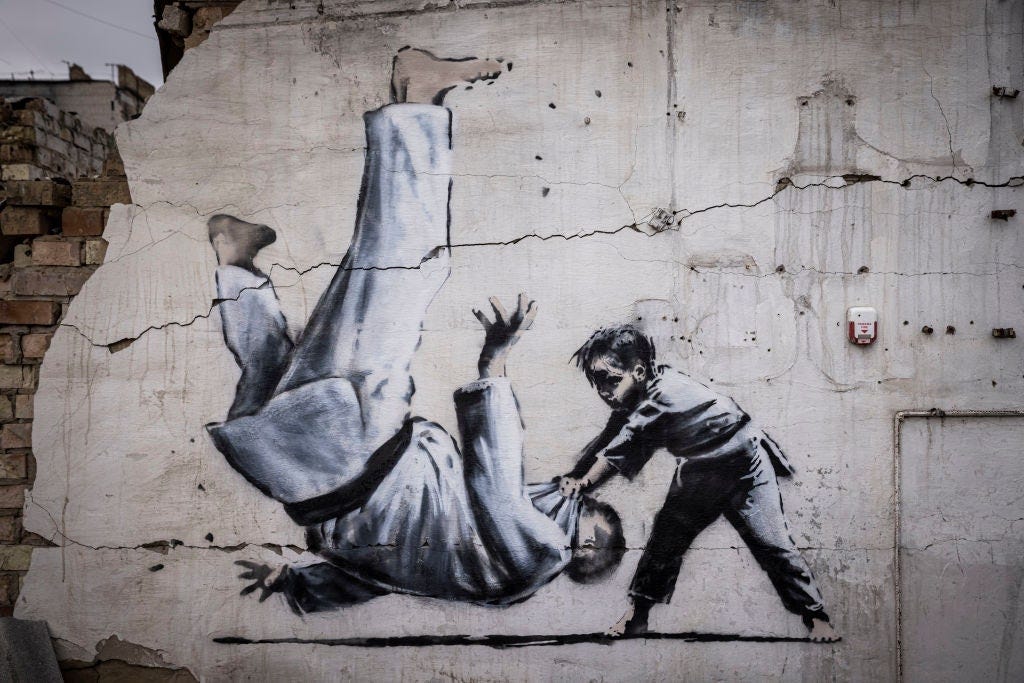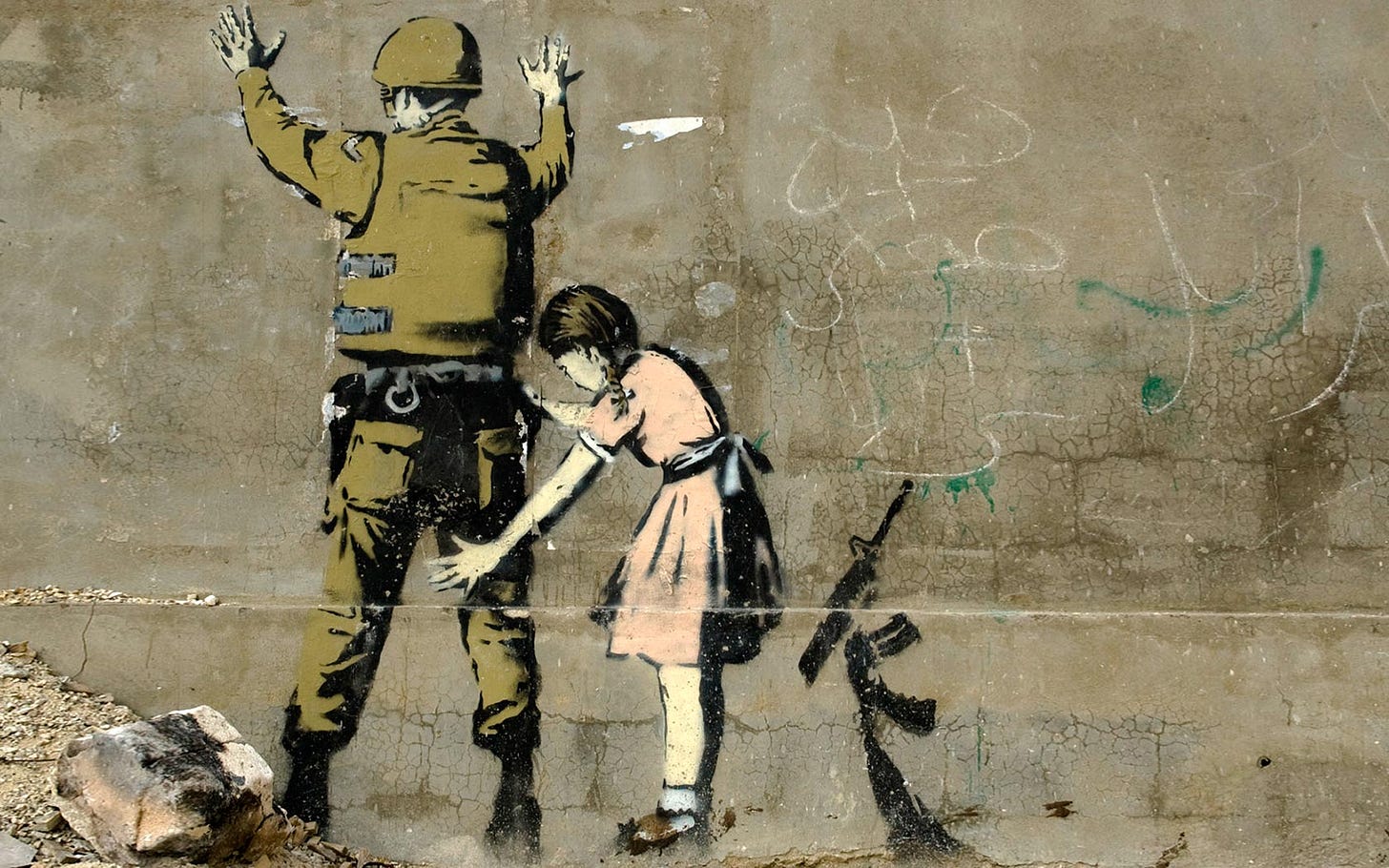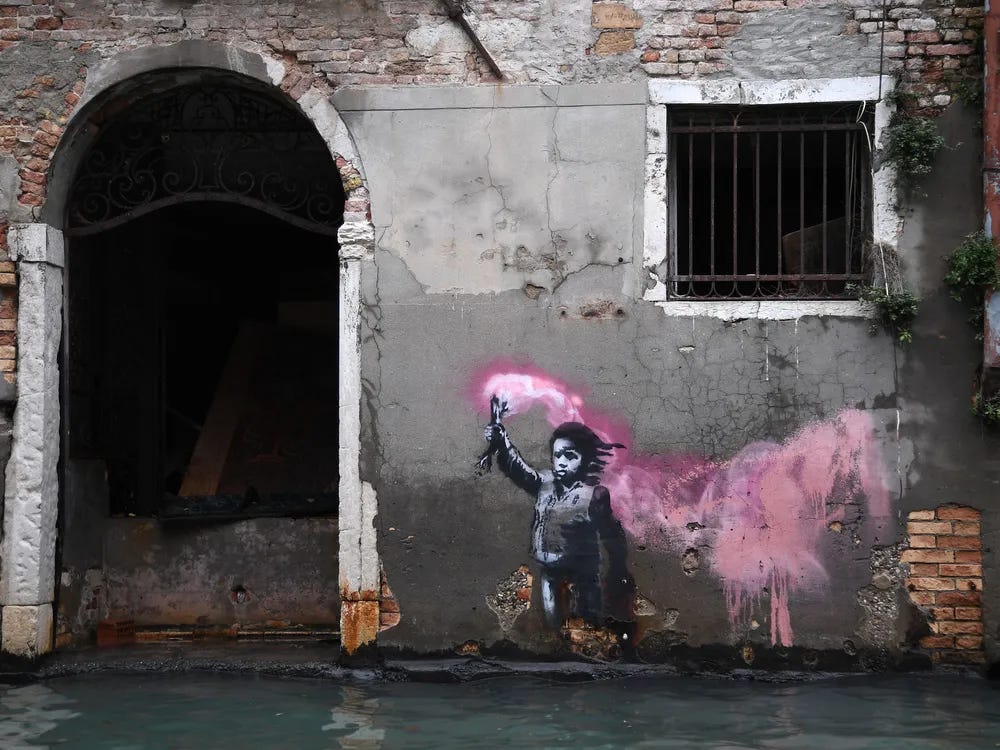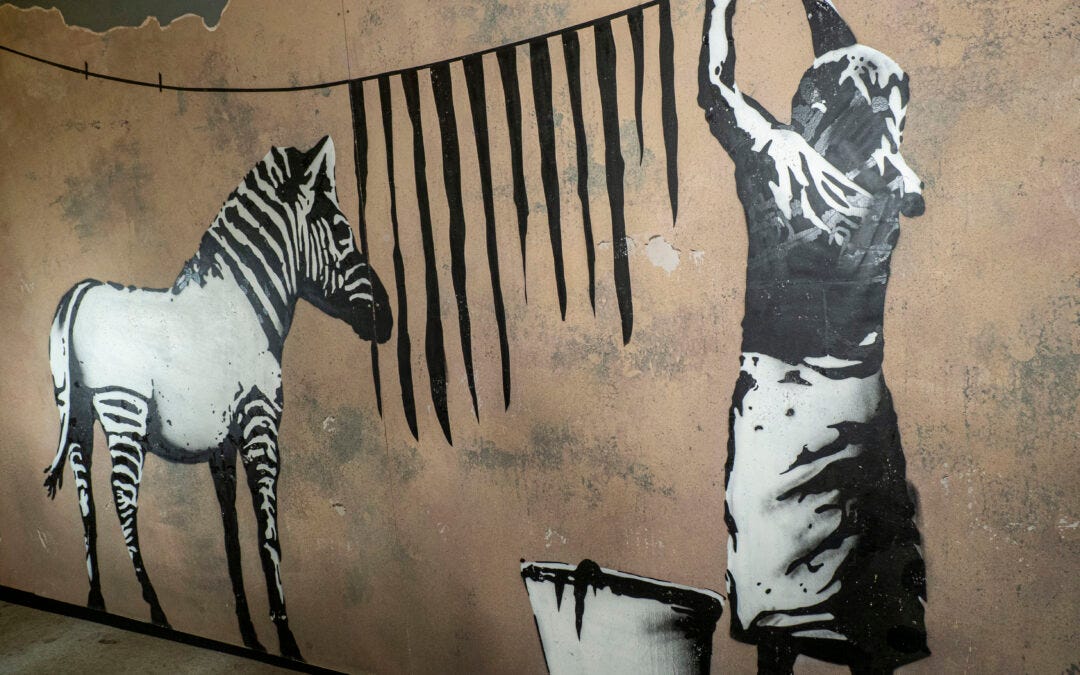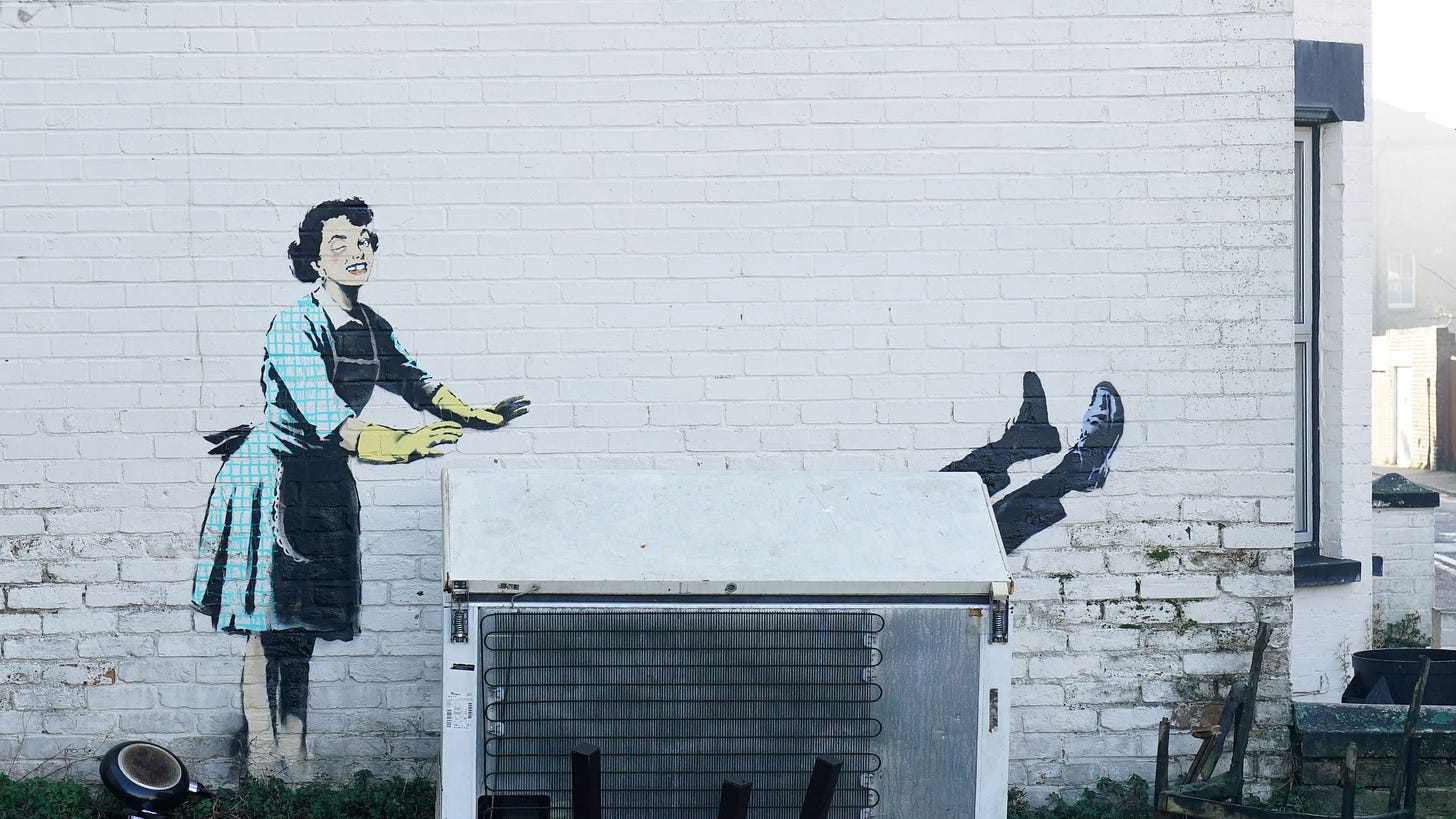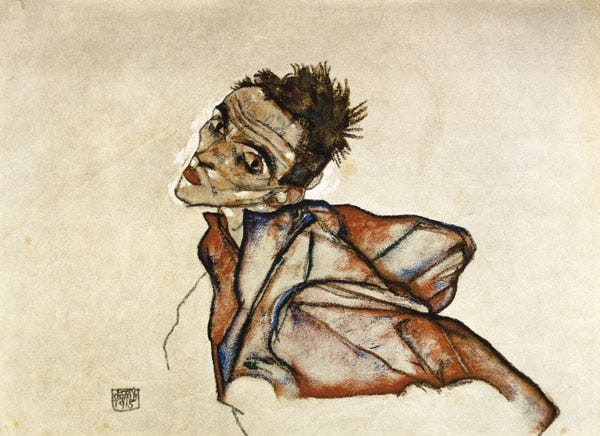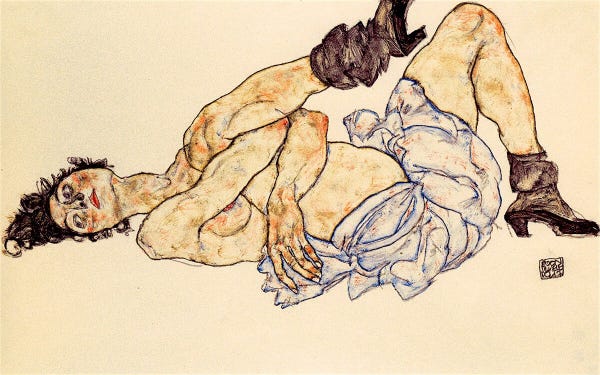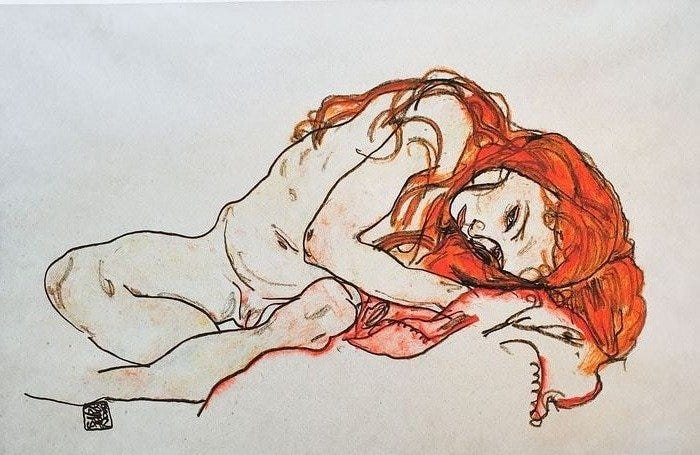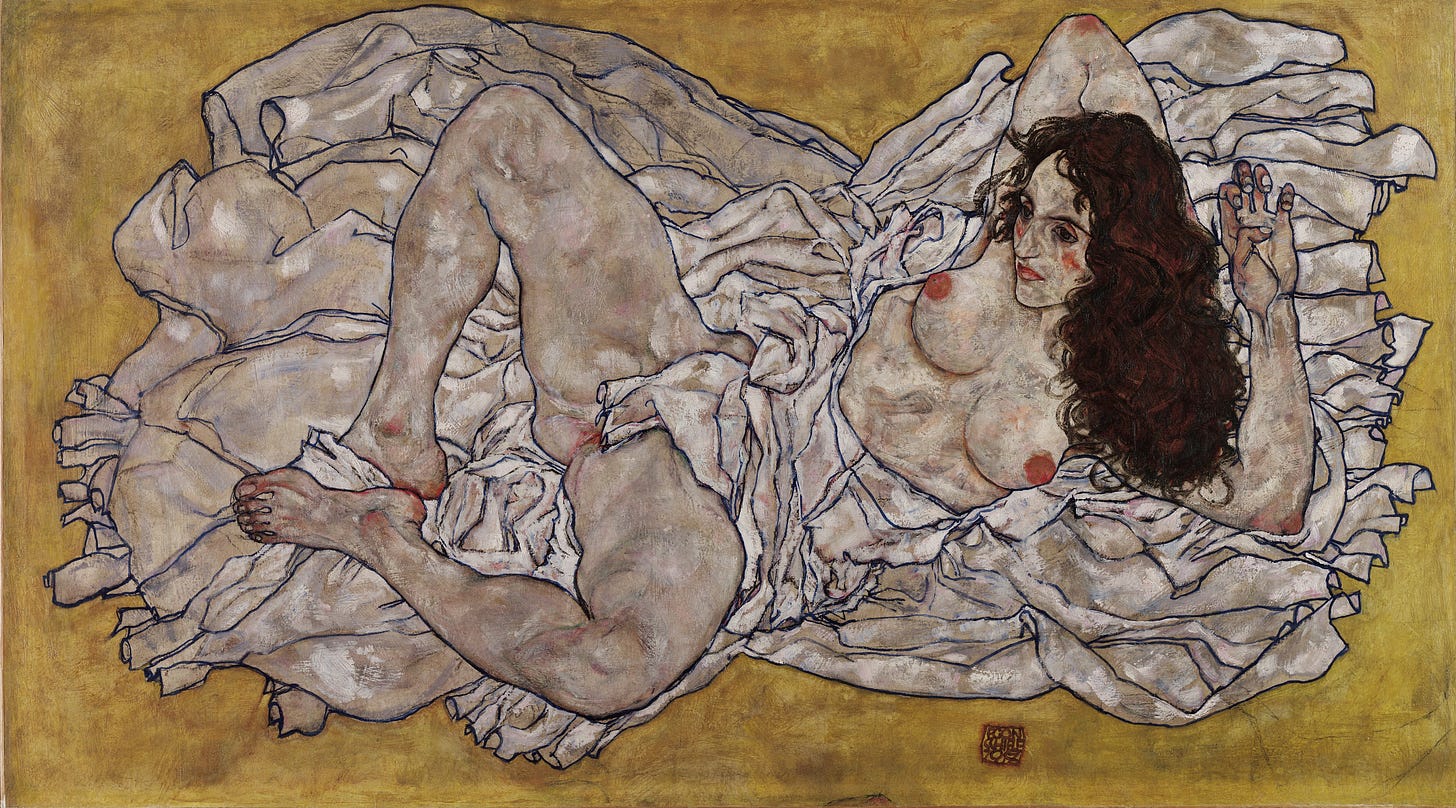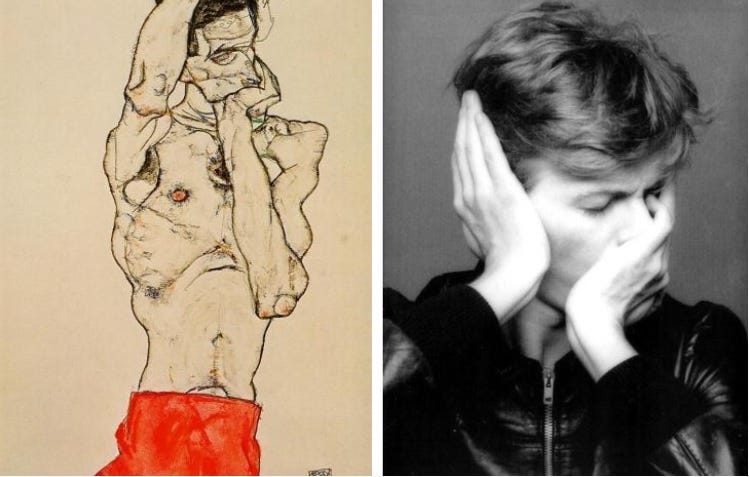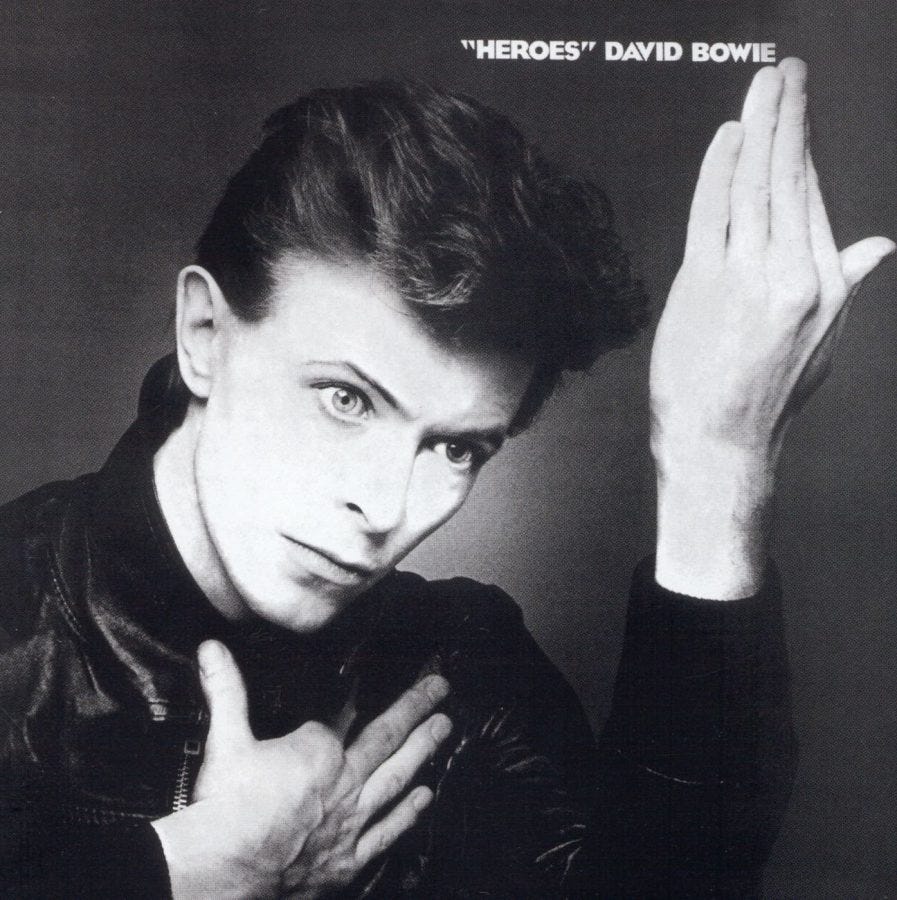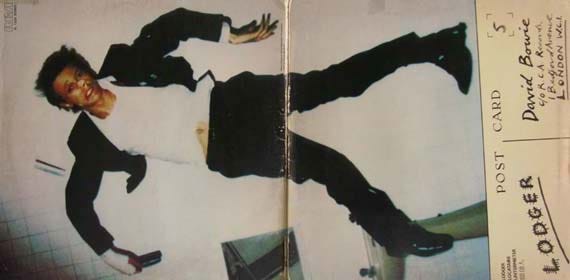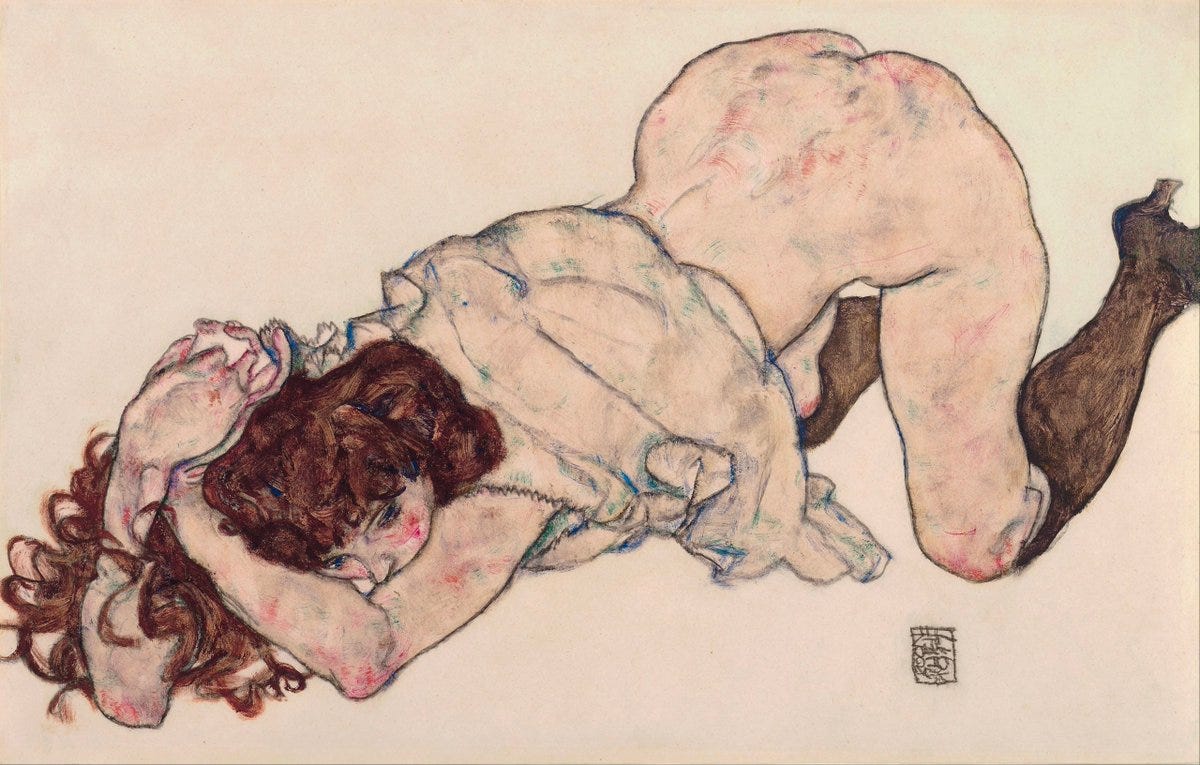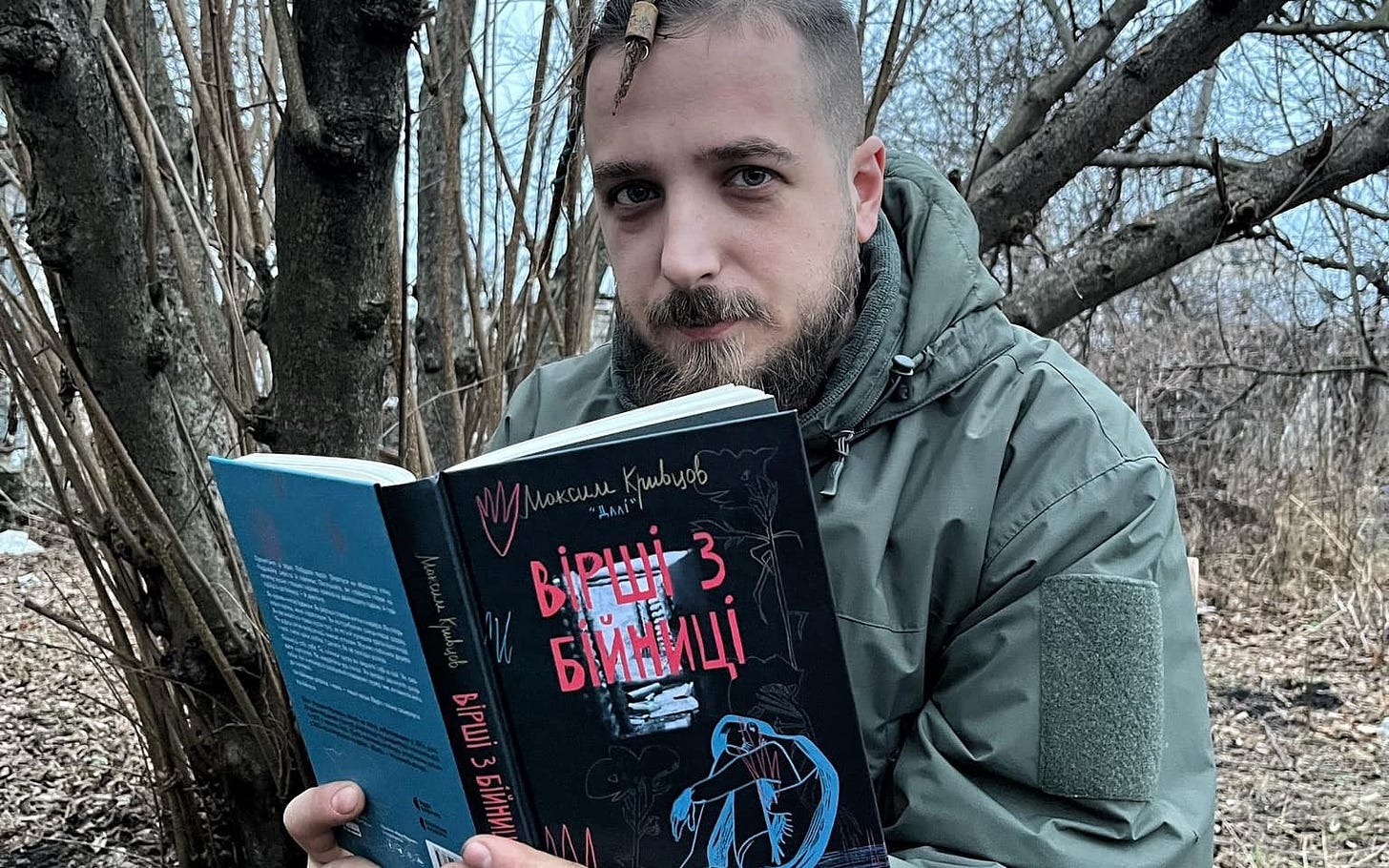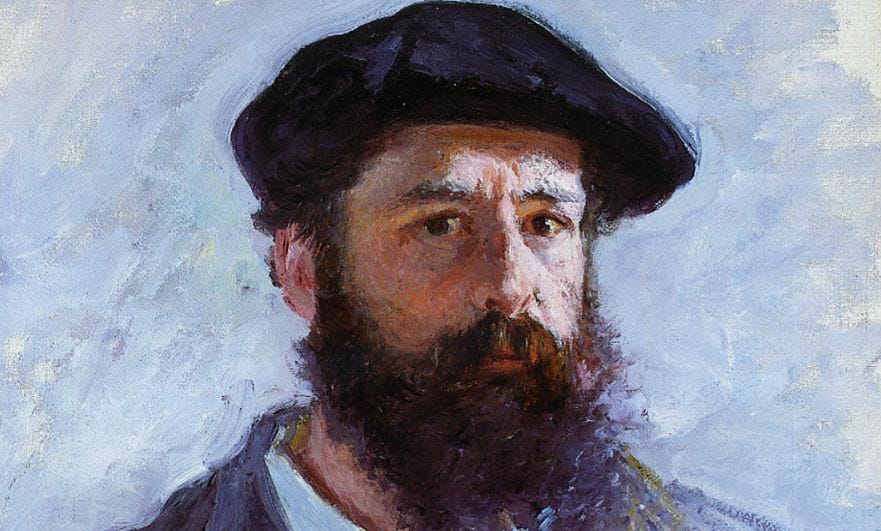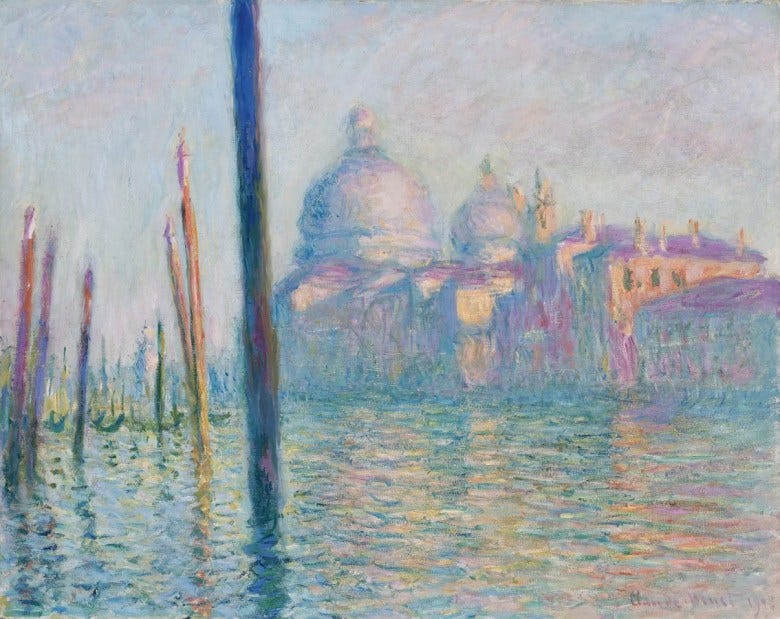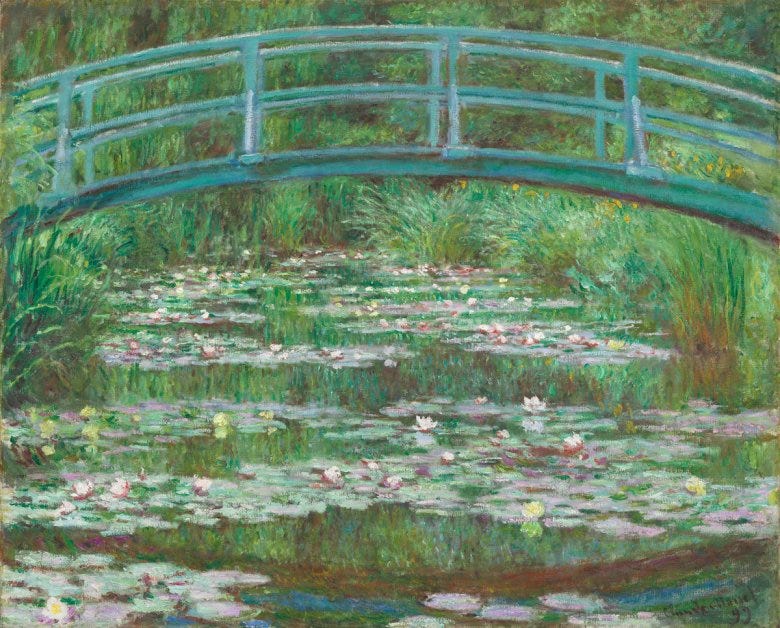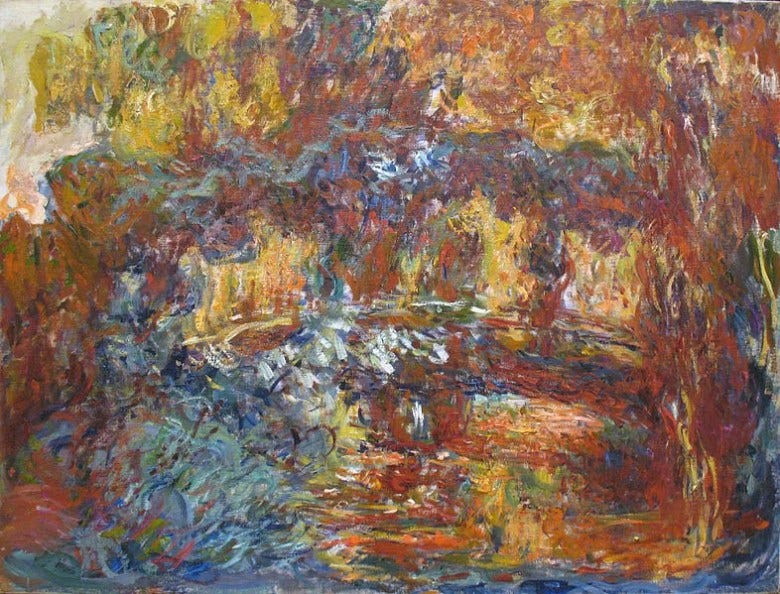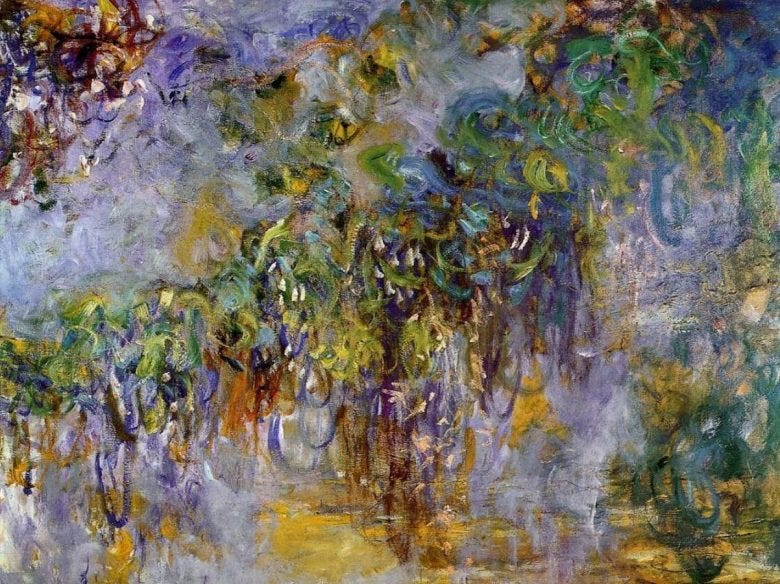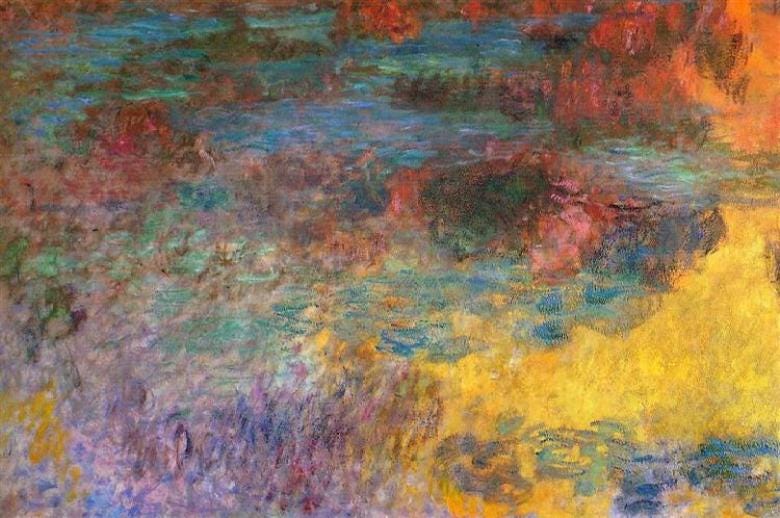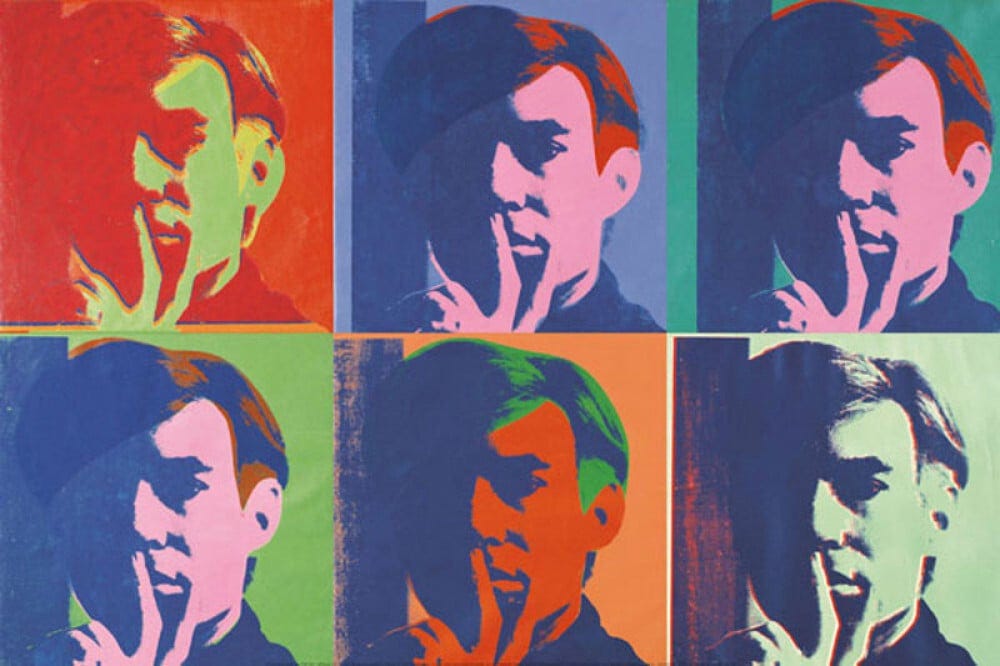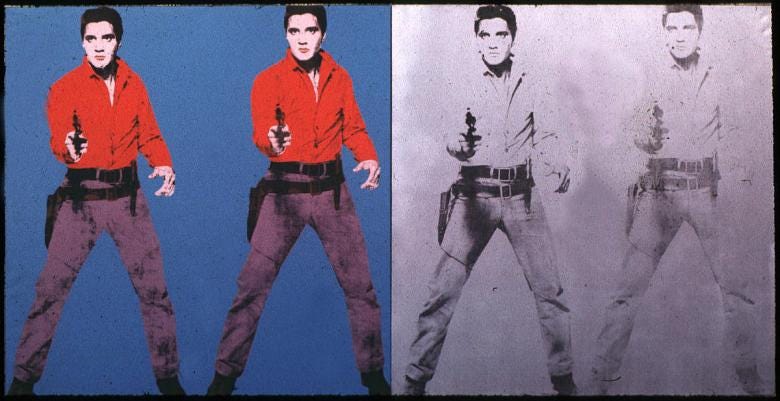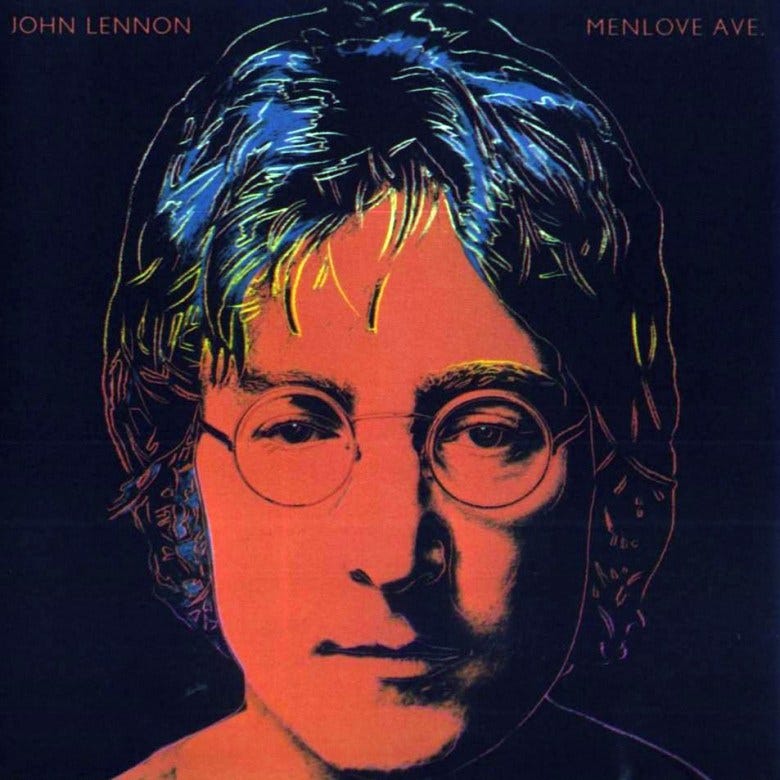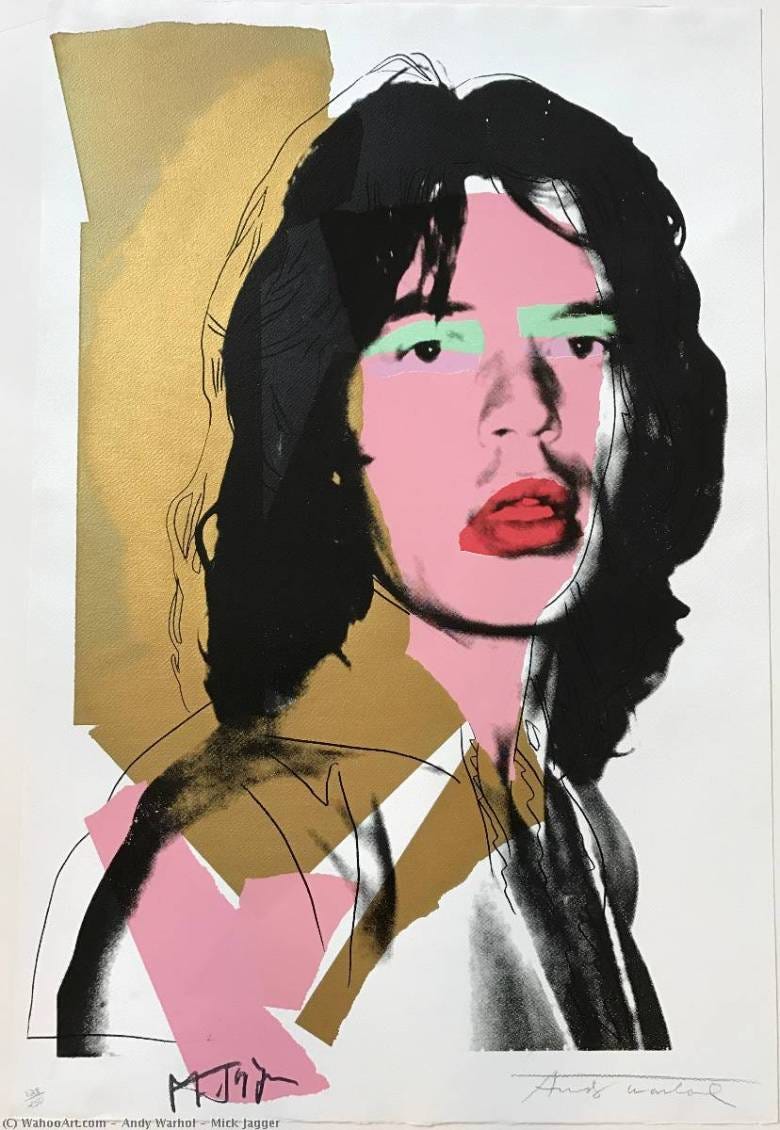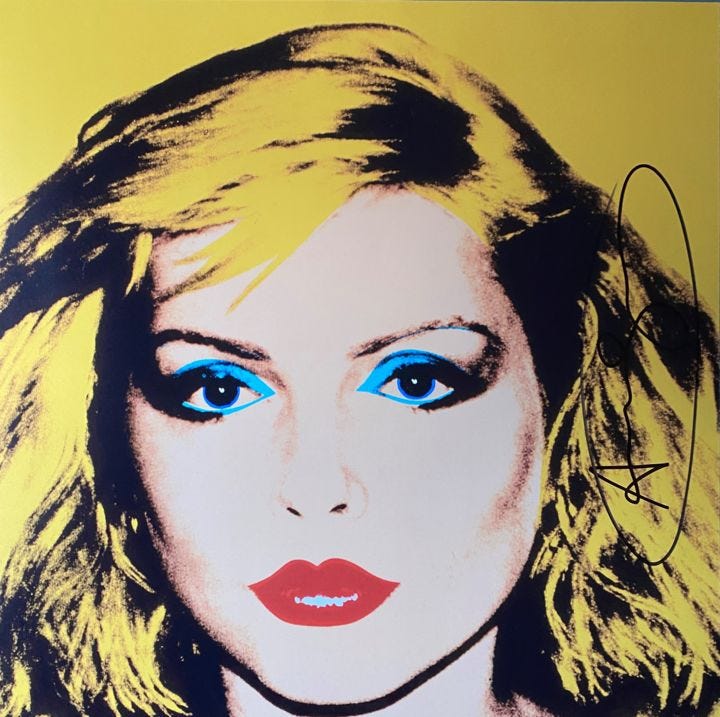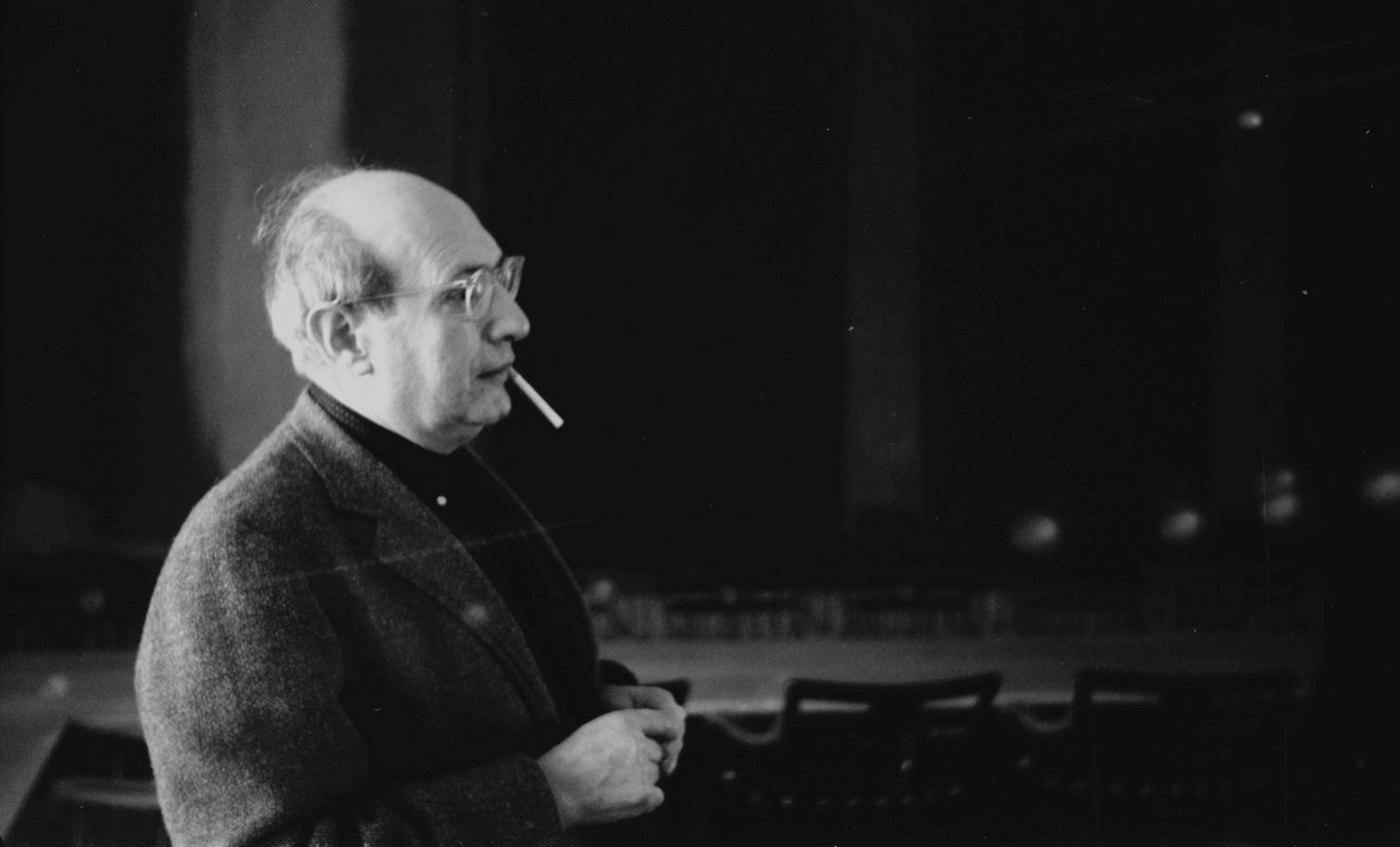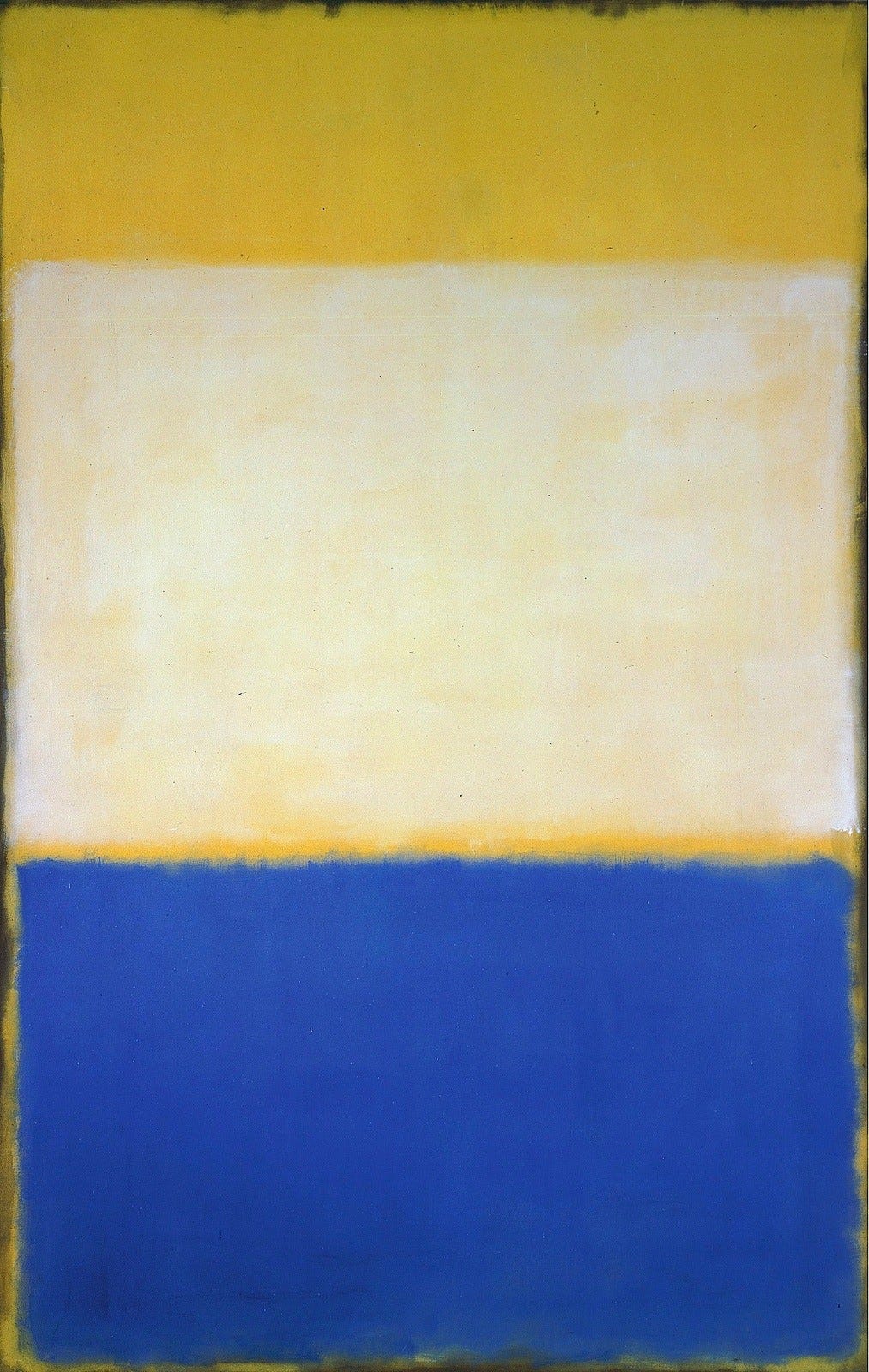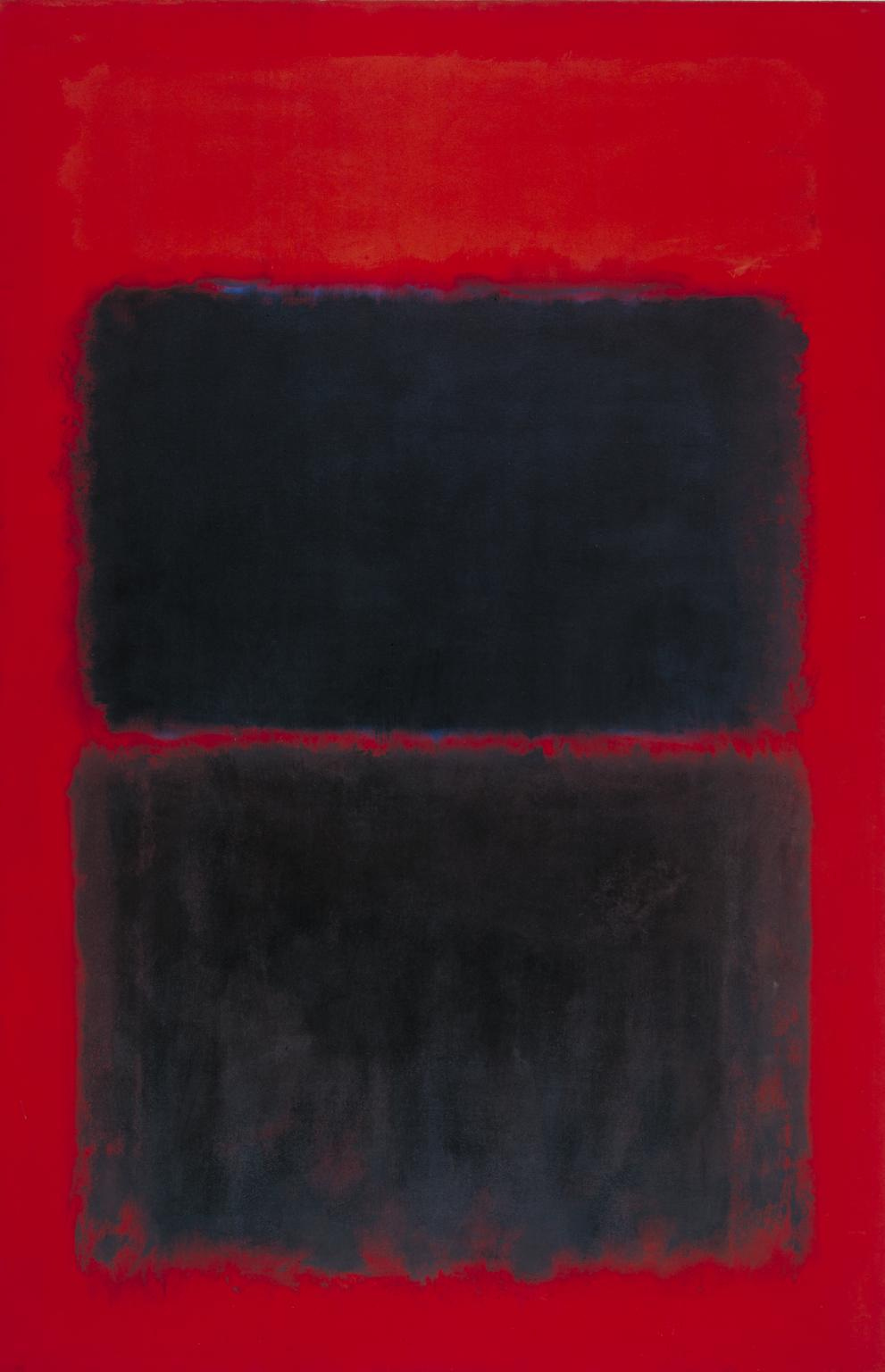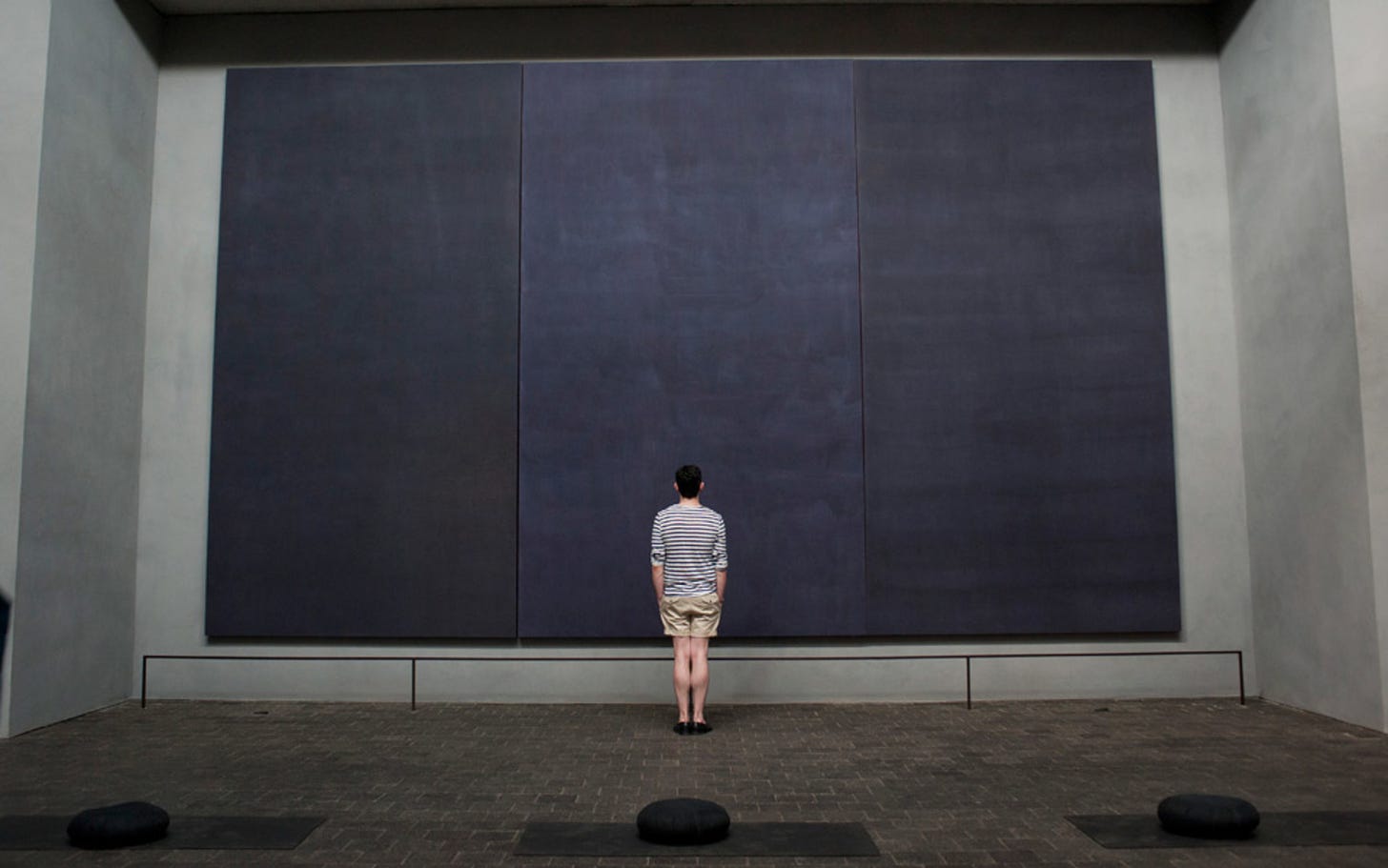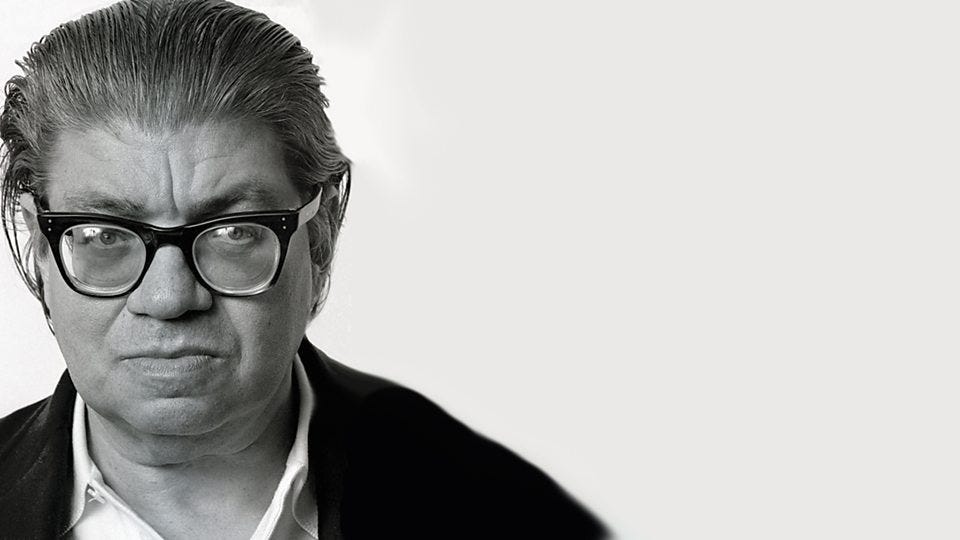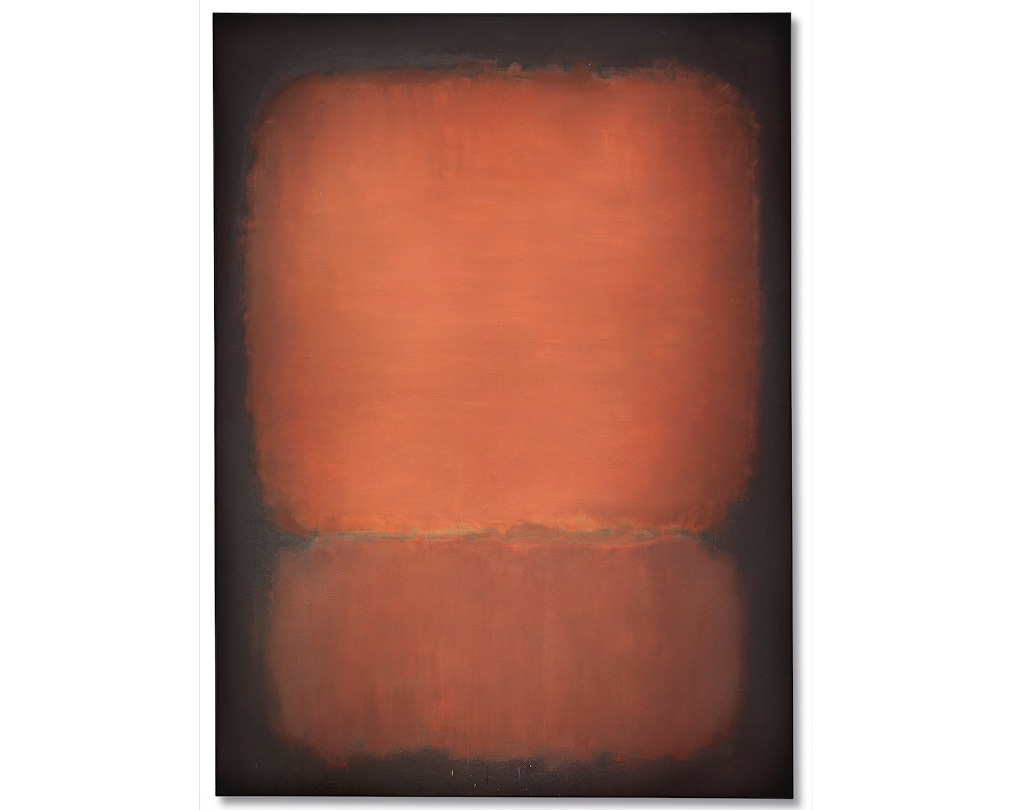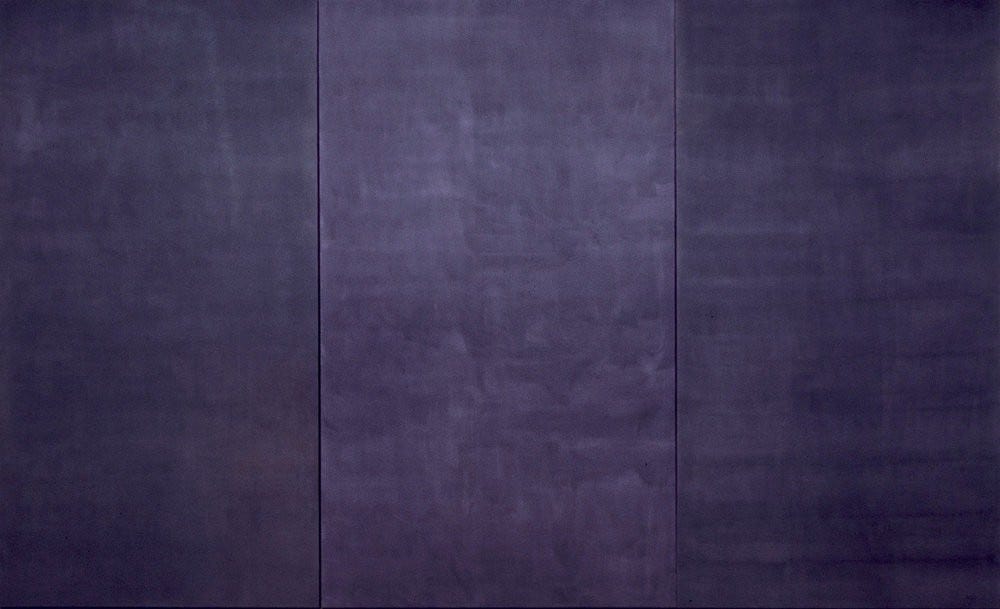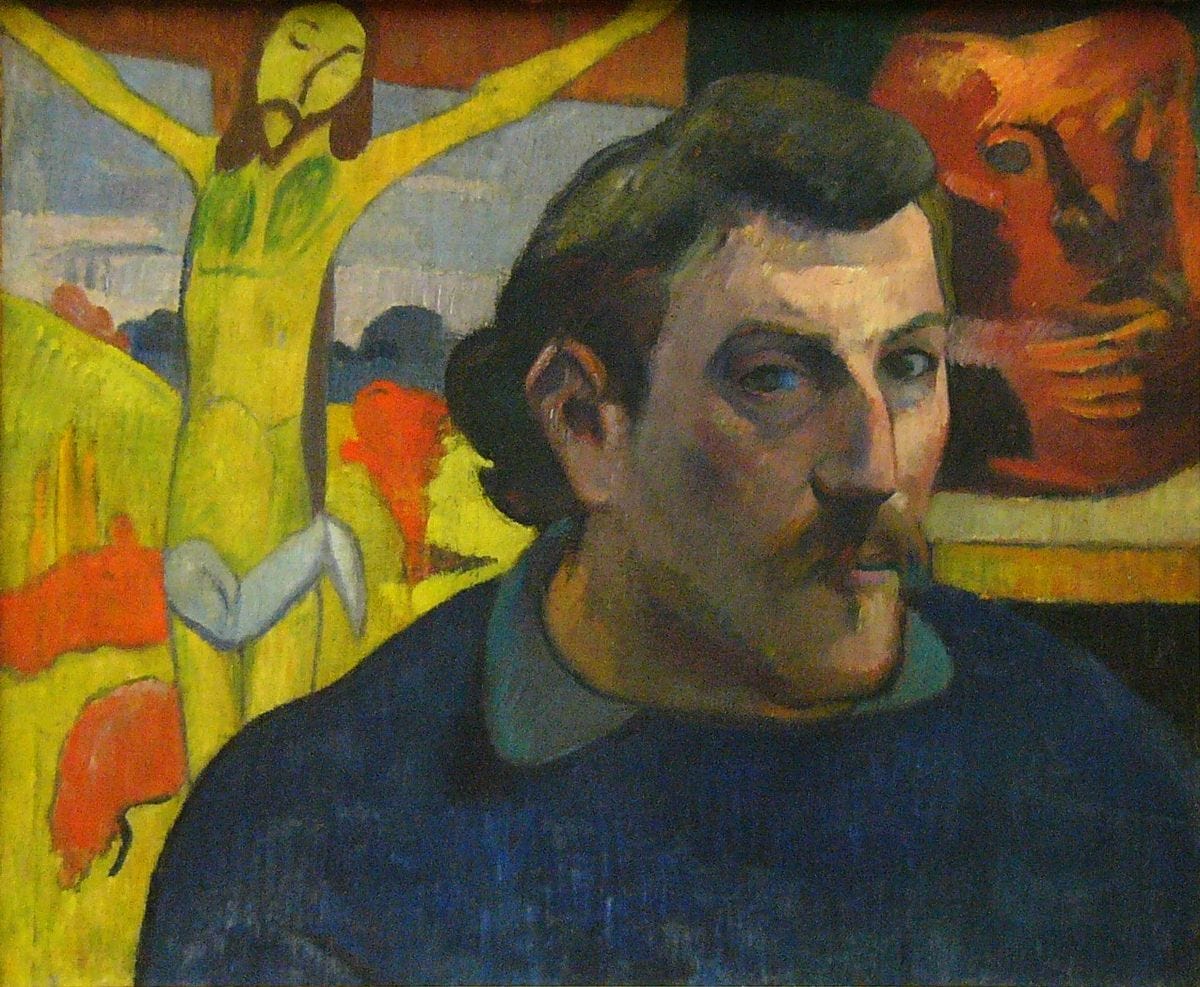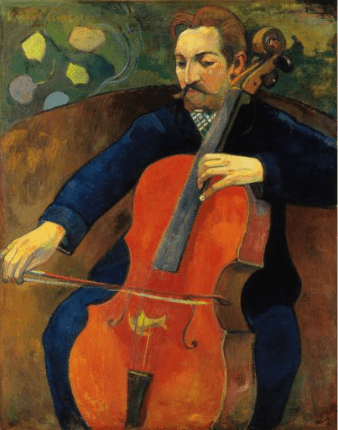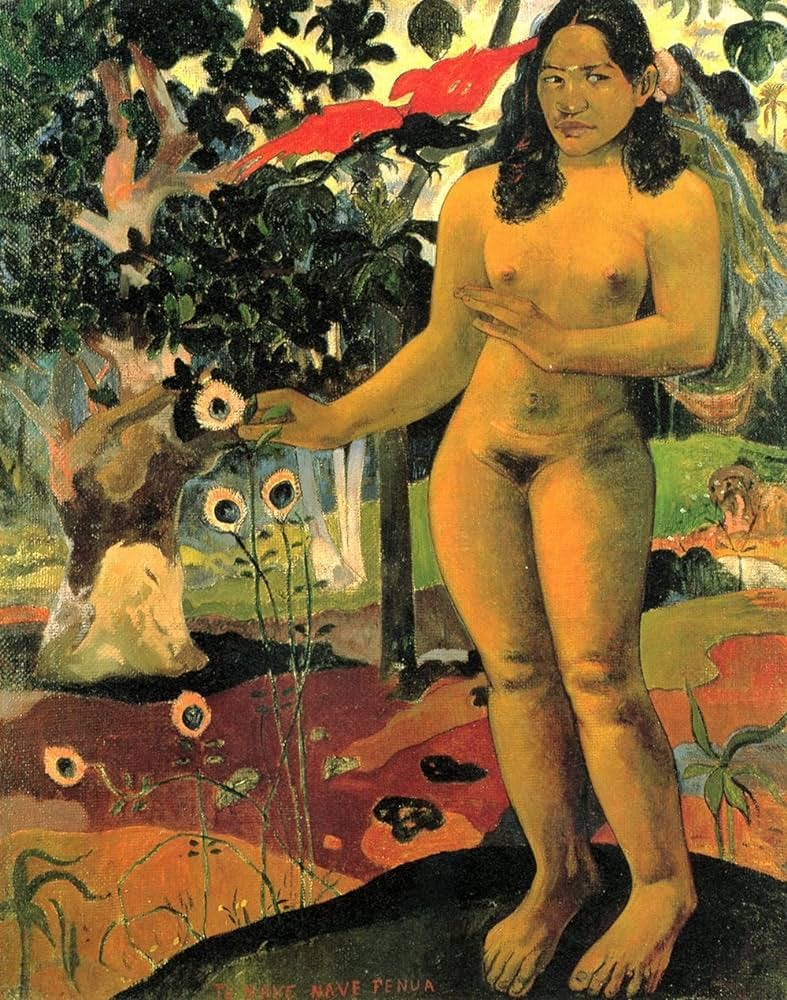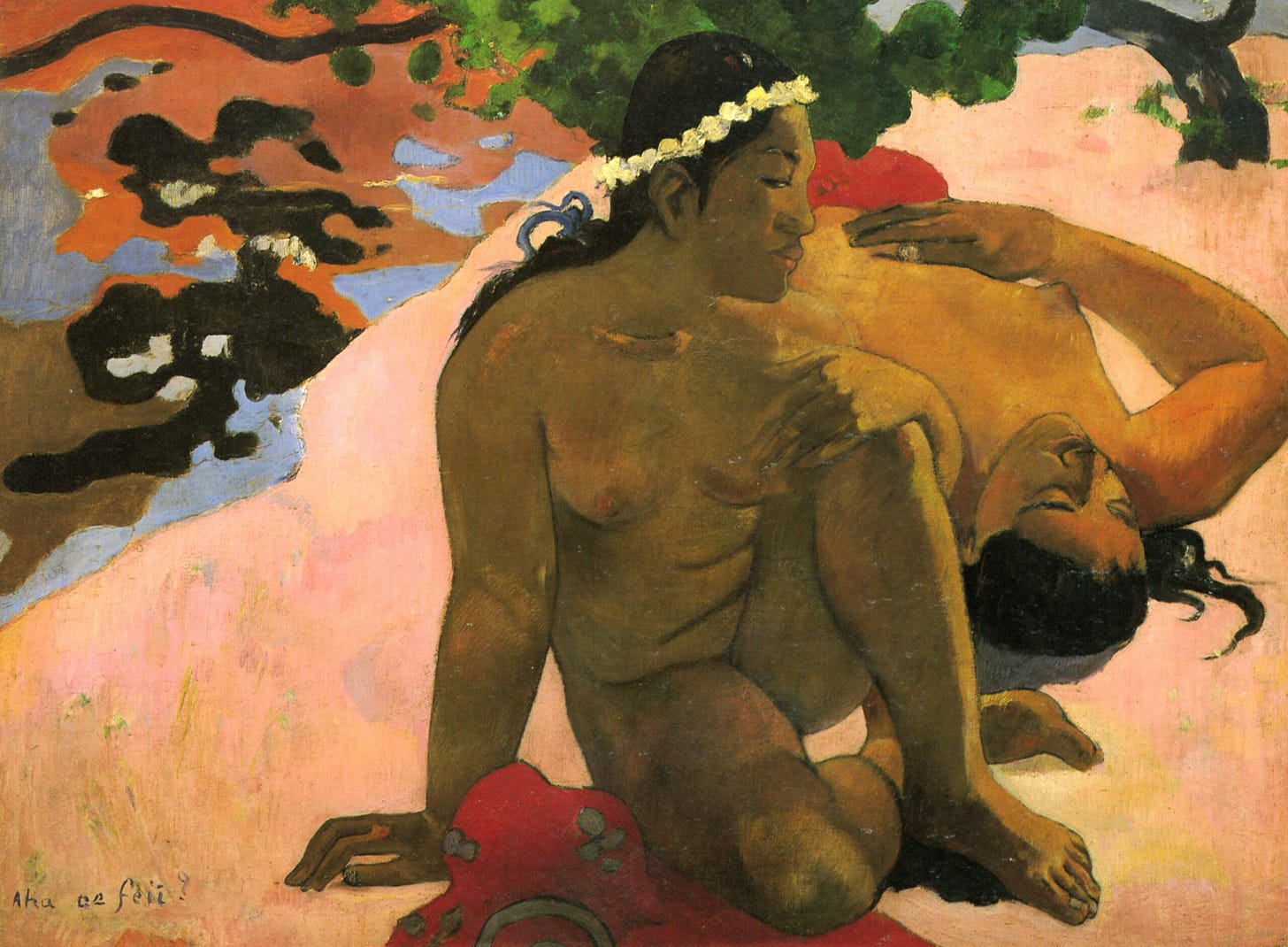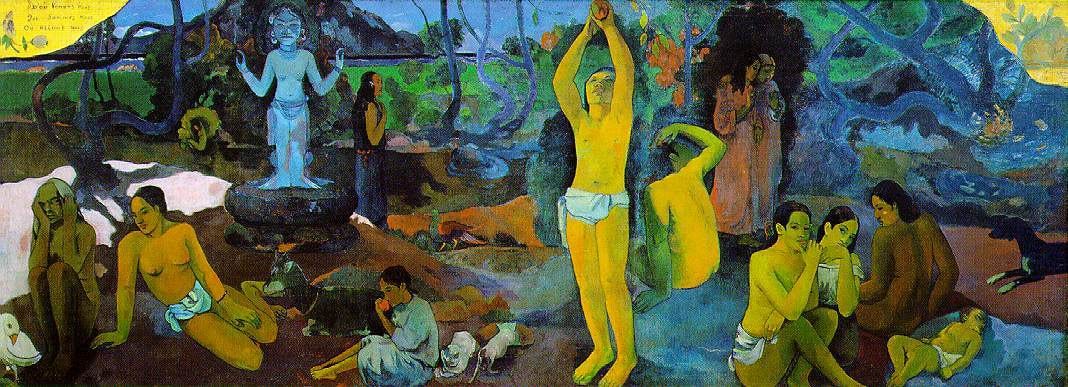A collection of musical stories related to painting, a journey where colors become sounds and sounds become colors.
Una raccolta di racconti musicali riferiti alla pittura, un viaggio dove il colore diventa suono e il suono diventa colore.
BANKSY
GAUGUIN PAUL
MONET CLAUDE
ROTHKO MARK
SCHIELE EGON
VAN GOGH VINCENT
WARHOL ANDY
Van Gogh and the sound spiral of colors.
Ah! my dear friend, to make painting what the music of Berlioz and Wagner was before us... a consoling art for afflicted hearts! There are still only a few who feel it as you and I do!!!
And in a painting, I would like to say something consoling, like a piece of music.
Painting as it is now promises to become more subtle - more music and less sculpture - indeed, it promises color.
Vincent Van Gogh
Vincent van Gogh (1853 - 1890) - Self-portrait - 1889
What is the connection between Van Gogh's dynamic, material, and expressive painting and music? What can we say about the great Dutch artist and his relationship with sound? Van Gogh himself and his extensive correspondence with his beloved brother Theo help us, revealing a fraternal bond that went far beyond blood ties, into spiritual closeness and fraternal love for each other. We know that during his stay in Paris, together with Theo, Vincent had the opportunity to attend several concerts featuring the music of Richard Wagner, and Van Gogh also read a book about the German composer. Paris was a crucial period for his painting. Here, he discovered the work of the Impressionists and opened his art to an explosion of colors, going beyond the Impressionists' momentary vision to immerse himself in the painting of interiority that made him famous.
Vincent van Gogh (1853 - 1890) - The Seine with the Clichy Bridge - Summer, 1887
Vincent van Gogh (1853 - 1890) - View of Paris - Paris, Summer 1886
Wagner described his compositions as musical dramas, designed to immerse the audience in a total and multisensory experience. He was an innovator who placed great importance on emotions, much like Van Gogh's feelings about painting: there is a commonality of intent between the two. Vincent van Gogh believed that music was one of the most comforting forms of art for people. The great Dutch artist saw in his Sunflowers (1888) a “symphony in blue and yellow,” and he also sought to paint “musically” in other works, creating a strong parallel between brushes and musical scores. Perhaps this is where the parallel path between art and music begins, leading to Kandinsky's approach, with a pictorial language that seeks to be a graphic score corresponding to specific instruments?
Vincent van Gogh (1853 - 1890) - Sunflowers - 1888
To reaffirm Van Gogh's connection with music, we know he also took piano lessons. This happened between 1883 and 1885 during his painting career. His teacher, Hein van der Zanden, thought he was dealing with a madman and was so afraid of him that he stopped the lessons. Why? Van Gogh continuously and obsessively compared painting with music. He kept comparing piano notes with Prussian blue and dark green or dark ochre with bright cadmium. He was too ahead of his time. The intensity of a creative mind like Vincent's is not easily controllable, and Van Gogh's associations between color and music were still very much alive in Arles a few years later. In a letter to his brother Theo in September 1888, he wrote: “But I am again as I was in Nuenen, when I made a vain attempt to learn music - even then - I felt so strongly the connections between our color and Wagner's music.”
Vincent van Gogh (1853 - 1890) - Starry Night - 1889
Aren't Van Gogh's skies, both day and night, an explicit symphony in the form of color? Don't the dynamic figures that “ignite” his canvases explicitly allude to sound masses? Van Gogh's statements confirm this very powerful tension to translate the invisible, which is typical of music, into the visible of painting. I have stayed true to Van Gogh's allusions to Berlioz and Wagner as beloved authors of the great artist to create a suitable playlist to immerse oneself in his colors: CLICK HERE to listen to it, perhaps while simultaneously admiring Vincent's paintings or using the player below that you will soon find in all the posts of (((RadioPianPiano))).
Vincent van Gogh (1853 - 1890) - Wheat Field with Cypresses - 1889
Lavandare
In the field half gray and half black
there remains a plow without oxen, which seems
forgotten among the light mist.
And rhythmic from the canal comes
the splashing of the washing women
with thick thuds and long chants.
The wind blows and snows the foliage,
and you have not yet returned to your village!
When you left, how I remained!
Like the plow in the fallow field.
Giovanni Pascoli
Banksy and the breath of a city.
Some people become cops because they want to make the world a better place, some people become vandals because they want to make the world a better looking place.
I need someone to protect me from all the measures they take in order to protect me.
Banksy
Self-Portrait, 2000
The breath of a city behind Banksy, the world's most famous street artist, capable of complex installations, adept at maneuvering media, making communication itself an artwork, delving into the infinite hypocrisy of an era, our own, which loves to forget everything that happens after a few weeks, erasing it. What city am I talking about? Bristol, a veritable creative hub from the late 80s through the 90s, with a unique music scene that innovated sound on planet Earth with Massive Attack and Tricky or set the rhythm in clubs around the world with Roni Size. All names that, as we will see, intersect with Banksy in one way or another. Banksy, who has created his works everywhere, always returns to Bristol punctually as if in search of an indispensable point of reference.
There is in his working method a clear return to the traditions of street art that originated as “Gesamtkunstwerk”, a total work of art, contemplating a real-time fusion of visual arts, music, and dance, namely street art, hip hop, and breakdancing. Banksy returns to that idea and alludes to it continuously, designing, as Andy Warhol had done in the past, album covers, events where graffiti and music intersect and blend. All this always seasoned with a biting irony, a perennial reference to surreal situations, such as when he buys 500 copies of Paris Hilton's album, the billionaire progenitor of influencers in which we drown today, modifies the cover in a satirical key, and prints remixes of the original tracks curated by the well-known DJ Danger Mouse: the artistic operation consists of music and visual parts in the alteration of a record product. I would venture to say conceptual art.
Banksy, the anonymous ghost, is undoubtedly music or rather it starts with music. According to what can be deduced from the artist's interviews. It all began in Bristol in the early '90s, among musicians like Portishead, Massive Attack, or Tricky, the fathers of English trip-hop: "When I was 10, a kid named 3D was painting the city streets. I think he had been to New York and was the first to bring spray cans to Bristol. Graffiti was what we loved most at school, and what they did on the bus ride home," says our artist in an interview. Always assuming that the little that has been told by Banksy is true, Bristol represented the turning point of his artistic inspiration. Who is 3D? Robert Del Naja, the mind behind Massive Attack and always at home in Bristol.
In the summer of 2015, Banksy creates Dismaland, an extensive temporary installation. A parody of an amusement park, a Disneyland in reverse, conceived to overturn the consumeristic perspective of the most famous brand-related amusement park. Here too, there is plenty of music: during five nights, Dismaland's audience saw artists from different backgrounds and genres perform, from Savages to Pussy Riot, the inevitable Massive Attack and Peanut Butter Wolf, and Run The Jewels and Mos Def. In a subsequent installation, the "Walled Off Hotel" built in Bethlehem (a hotel overlooking the wall built by Israel in Bethlehem), music is at the center of entertainment for guests: a remotely controlled piano plays concerts by famous artists, such as Elton John, Hans Zimmer, Trent Reznor, and Massive Attack. You've read the names of many musicians, CLICK HERE to listen to a playlist that collects Banksy's favorite songs and that surely inspired him.
And while a pseudo-artist from Italy, whose name I don't remember, embraces the criminal at the Kremlin, wanted by the International Criminal Court in The Hague for deporting thousands of Ukrainian children, Banksy, with his usual biting irony, creates amidst the ruins of a Ukrainian building a small David who, with a winning move, topples a big Goliath in a judo clash, a discipline dear to butcher Putin. It's easy to see an effective and immediate metaphor, a biblical reference, and a wish for all Ukrainians. Banksy is a free spirit, an artist, the Italian graffiti artist a poor character afflicted by mediocrity. Who is Banksy? What does he think? I wonder if it's important to know, don't his works speak very clearly?
I seen you go down to a cold mirror
It was never clearer in my era so
You click a shine upon your forehead or
Check it by the signs in the corridor
You light my ways through the club maze
We would struggle through the dub daze
I sink myself in hair upon my lover
It's how you go down to men's room sink
Sad we talk how madmen think
I sink myself in hair upon my lover
I don't know her from another miss
I don't know you from another
See me run now you're gone, dream on
Why you want to take me to this party and breathe
I'm dying to leave
Every time we grind you know we sever lines
Where have those flowers gone
Long time passing
Why you keep it testing, keep on tasking
I keep on asking
Toy-like people make me boy-like
Toy-like people make me boy-like
They're invisible, when the trip it flips
They get physical, way below my lips
And everything you got hoi-poloi like
Now you're lost and you're lethal
And now's about the time you gotta leave all
These good people, dream on
Nicer than the bird up in the tree top
Cheaper than the chip inside my lap top
All the variations you could do with me
Nicer than the girl up in your mind you're free
Automatic crystal remote control
We come to move your soul
You're gonna fade into the background
Like a better smoke'll bring you back round
Like a man slide inside you my dear
Your cheap beer's filled with crocodile tears
See 'em run now you're gone, dream on
Toy-like people make me boy-like
Toy-like people make me boy-like
I found a reason
I found a reason
Dream on
Dream on
Dream on
(Massive Attack “Risingson”)
Egon Schiele and the wide-open Body
Art cannot be modern. Art is primordially eternal.
At present, I am mainly observing the physical motion of mountains, water, trees and flowers. One is everywhere reminded of similar movements in the human body, of similar impulses of joy and suffering in plants.
Egon Schiele
In a quirky and overly prolonged postmodernity, a herd of sad "intellectuals" is engaged in constructing moralizing narratives where fairy tales need to be corrected and sweetened even in Italy, reconstructed and altered, as happened to Roald Dahl, to avoid hurting anyone and rewritten to erase what superficially appears as stereotypes to be fought against. Cursed traditional tales infested with imaginary traps for young and old that will condition their future lives, ruining them!
Encountering Egon Schiele is a breath of fresh air compared to the stale rooms where bizarre theories of the genre are elaborated. Schiele, the man who made eroticism a constant theme in his work, throws the thrills of his figures in the face of bourgeois respectability. Isn't the "ideal cure" for those seeking the right moral measure in everything? The body, the hair, the nipples, the genitals, the twisted hands, the reversed arms, the crossed, united, intertwined legs take your breath away, words, and the ridiculous constructions of weak thoughts. The body, the place of the true unavoidable, mocks those who acrobatically cling to words, to a supposed ethics to cut and censor in the name of the reissue of stale ideologies, sinking and wanting to make us sink into the mold of authoritarianism. Schiele's bodies, on the contrary, wide open to desire, burn with wild freedom. And truth.
For Schiele, sex is the fire in which to incinerate these already flaming fictions while Europe was heading towards its first world conflict, mired in the blood of a mad slaughter. In the warmth of embraces, in the sharp edges of his nude figures, we remain entangled with our eyes because they testify to the urge to go beyond, breaking every convention, as in the most scandalous stories of Bataille. While the entire Austro-Hungarian Empire ominously creaked and everything sank into an increasingly dark twilight, Schiele, protected by Klimt, pushes to the extreme, gets thrown in jail after a report accusing him of having a relationship with a fourteen-year-old, while he was already involved with a minor, Wally Neuzil, his muse and model, and almost loses himself in this spiral of flesh, pleasure, and desire. A few strokes are enough for him to outline entire bodies, bodies floating in a white, absent space, in a landscape now disappeared, where man is alone with his impulses. Clothing, hairstyle, show us a Schiele anticipating a punk aesthetic but, above all, in the contortion of the bodies reflects an existential discomfort that is epochal and emerges codified and well-told by psychoanalysis in Freud's Vienna.
His characters seem like puppets moved by invisible threads and have inspired important artists, such as Francis Bacon, who dealt in parallel with the relationship between the body and psychological anguish, and others like Julian Schnabel, Tracey Emin, Jean-Michel Basquiat (clearly inspired by his work), and David Bowie. The Bowie of the Berlin Trilogy (Low, Heroes, and Lodger) and the albums "The Idiot" and "Lust for Life" with Iggy Pop immerse themselves not only in the electronic sounds of Kraftwerk known during his Berlin sojourn and the ethereal atmospheres of Brian Eno but also in the painting that, from Schiele, rises towards the German expressionists. Always passionate about art and also a painter of some talent himself, Bowie cultivates all these suggestions in his path of rebirth and builds a poetic inspired directly by Schiele for the shots on the covers of "Heroes" and "Lodger."
So these are the threads we knot in our sound journey today: on the one hand, Alban Berg as a contemporary of Schiele, Berg traversed in his scores by the same lunar atmosphere, from the sunset of a world that fades forever, and in parallel Bowie, a refined interpreter of the poetry of the great Viennese to the point of bringing it to the covers of his records. Not coincidentally, Bowie's music fits perfectly with that of Alban Berg, despite over half a century of distance and the juxtaposition of acoustic and electronic instrumentation. Although distant chronologically, these compositions, close in terms of poetics, tell the crumbling of a world, a world in which Schiele himself tries to find emotional stability, marrying Edith Harms and trying to build a family, but in that world (ours?) where there was no peace, the Spanish flu epidemic sweeps them both away. CLICK HERE and embark on a sound journey in a decadent and expressionist Europe to accompany the works of Egon Schiele.
All this is also a stratagem to celebrate Bowie, who would have turned 77 on January 8, and, like Schiele, is still here with us, and both will keep us company for a long time for their ability to seek the authentic, pushing to the extreme of what is human, leaving behind the small coastal navigation of ephemeral narratives dedicated to erasing the inconvenient, the all too human, to disinfect everything in a false and lifeless artifact. Schiele's lustful bodies and Bowie's magnificent music, on the contrary, remain imbued with life, in its rapid and incomprehensible unfolding.
In conclusion, a thought for Maksim Kryvtsov, the Ukrainian poet who died on the front a few days ago, another artist given to death by Russian invaders. The sacrifice of these men and women throws the sense of truth, never domestic, consolatory, and sweetened but raw and direct, impregnated with strong smells and less delicate tastes, like the works of Egon Schiele and the poems of Maksim, in the face of a confused West. Rest in peace among the flowers that you will soon be.
My head rolls from one grove to another
like a rolling field or a ball
Violets in spring will bloom
through my torn arms
When will spring come?
I can't wait to bloom like a violet
Maksim Kryvtsov
Monet and the dissolving world.
Colours no longer looked as brilliant to me as they use to do [Monet’s sight was beginning to fail], I no longer painted shades of light so correctly. Reds looked muddy to me, pinks insipid, and the intermediate or lower notes in the colour scale escaped me. As for forms, I could see them as clear as ever, and render them as decisively. At first I tried pertinacity. How many times I have remained for hours near the little bridge, exactly were we are now, in the full glare of the sun, sitting on my camp-stool, under my sunshade, forcing myself to resume my interrupted task and to recapture the freshness my palette had lost! A waste of effort.
Claude Monet
In 1883 Monet with his family moved to Giverny near Paris, and here he created what we can boldly categorize as a "living installation" that is, a magnificent garden to be cultivated and cared for first and painted later. A sumptuous setting where the artist creates a corner of paradise. His work is now recognized and the fame of his paintings gives him financial peace of mind. In 1908, however, Monet begins to complain of weakened eyesight, the right eye in particular, and faces several medical examinations. The response is unfortunately concurring: cataracts. The ailment that today is treated with routine surgery then led to blindness or alternatively to a very risky and painful operation with no guaranteed result. From 1908 in a relentless progression, the disease altered Monet's perception of colors, which replaced their actual perception with one conditioned by yellow: reds became orange, greens lightened, blues and purples turned to reds and yellows, and the edges of the figures no longer appeared sharp but blurred. Already the paintings painted by Monet in 1908 in Venice show the beginning of this metamorphosis.
Claude Monet, Grand Canal, Venice, 1908, Museum of Fine Art, Boston
Obstinately and even in understandable distress, Monet continued to paint with stubborn determination. Having become blind by 1922 he will face a series of operations that with partial results will bring him improvement in the last years of his life. The paintings of this period in which the quality of the great French artist's eyesight is very bad, show an increasing tendency toward abstraction and undoubtedly show us mental images rather than subjects that came out of a well-defined visual perception. Just compare the "Japanese Bridge" that is part of the Giverny garden painted before the illness and during.
Monet Japanese bridge, 1920/1922, Museum of Modern Art, New York.
Monet does not experience this metamorphosis of his work as a poetic opportunity, but as a limitation, an obstacle. However, if the artist's understanding is relevant to understanding his work, it remains that our enjoyment of the paintings of those years and is inexorably untethered and falls into a world of signs totally different from Monet's. We look at these paintings as works close to abstraction and in fact they are, being precisely mental images, glimpses of infinity. So I offer some of the works from that period from 1908 to 1922 and of course a series of sound commentaries that I have designed to accompany Monet's paintings: CLICK HERE to discover the Impressionist soundtrack to these works. There are some classics of his era from Satie to Debussy (we talked about the great French composer with Olrando Furioso also HERE) music with a sensibility and compositional characteristics that refer directly to Impressionism to which I have combined pieces that are decidedly more contemporary, but I think ideally connected to those atmospheres, from Sakamoto, insieve to Alva Noto, to John Cage to Morton Feldman, for a listening path that asks for a bit of commitment, but I think has its own internal coherence. The piano as an instrument accompanies all listening, searching for images that are more imprinted in the memory than protagonists of reality and have undoubtedly fascinated the artists of the following decades. Allow me an ideal dedication and it is for Ryuichi Sakamoto (we talked about him HERE) the great Japanese musician, unfortunately seriously ill... Art and illness interact today, because even if the evil does not fade away art remains a cure for the spirit and Monet teaches us that too. Happy listening!
Claude Monet, Wisteria, 1920, Musée Marmottan-Monet, Paris (detail)
Monet, Water lilies in the evening, 1916-1920, Kunsthaus Zürich, Zürich, Switzerland.
Andy Warhol a walk on the wild side.
Scripts bore me. It's much more exciting not to know what's going to happen. I don't think that plot is important. If you see a movie of two people talking, you can watch it over and over again without being bored. You get involved - you miss things - you come back to it ... But you can't see the same movie over again if it has a plot because you already know the ending ... Everyone is rich. Everyone is interesting.
I see everything like that, the surface of things, a kind of mental Braille, I just run my hands over the surface of things. I consider myself an American artist. [...] I represent the U.S. with my art, but that doesn't mean I am making social criticism-I represent those certain objects in my paintings because those are the things I know best. I am not at all trying to make a criticism of the U.S. or trying to show its ugliness: I am just purely an artist.
Andy Warhol
After World War II, the world got back on its feet, televisions and supermarkets drunk on wealth, and here in Italy these are the years of the economic boom, customs change, new ideas and cultural models circulate. Andy Warhol in his ineffable ambiguity is one of the fathers of contemporary art and he inhabits this very era, the fabulous 1960s, la Dolce Vita where Fellini also wrote a very blond Nico, the American artist's muse... I am not exhilarated by his work aesthetically, except for the series of "car crashes" and "electric chairs" seen at the Centre Pompidou and of great impact, but in the history of art today his weight is unquestionably enormous. Warhol looks with great acuity at contemporary myths, constructing a visual grammar of immediate impact and readable by anyone, even if totally unfamiliar with art. Thus the paradigm of the historical avant-gardes of the 20th century, that is, of an art made to be understood by a few, which required explanations, writings, theories, manifestos, punctual and specialized knowledge, think for example of Kandinsky's abstractionism is definitively erased.
Warhol erases all this: art is simply what it appears and to make what appears well understandable Warhol looks at contemporary myths, just as the ancient Greeks had theirs in Olympus and on those myths they built an aesthetic, so the great American artist looks at the projections of contemporary man and on those he builds his aesthetic. Rock and music are one of the bases, if not the most important base on which Warhol works to build the myth of himself and of a world easily understood by those who look at his works. That is why he paints and surrounds himself with rock stars or movie stars: they are a great popular myth.
Andy Warhol paints images of Elvis Presley, Mick Jagger, John Lennon, Liza Minelli, Prince, Debbie Harry, you name it.. He transformed a place, the Factory, and from 1962 to 1968 turned it into a laboratory of reference for creativity in New York. Here the famous serial silkscreens of the father of Pop Art with portraits of Mao were born (still forbidden to circulate in China today: it would be disrespectful of the "great helmsman") of Marilyn Monroe, Liz Taylor and so many others, but it is at the same time also a film set, a place for fashion shows, a party hangout, the practice room of the legendary Velvet Underground of Lou Reed, John Cale and the beautiful Nico... Here converge to revel in derailing parties Jim Morrison of the Doors, Lou Reed, Nico, Mick Jagger, Bob Dylan, David Bowie and many other "stars" of the rock firmament. It is no coincidence that Andy Warhol is also involved in the applied arts by signing the artwork of vinyls that have entered legend such as the Velvet Underground's first, Sticky Fingers and Love you live by the Rolling Stones, John Lennon's Menlove Ave and many others. The Velvets' banana and the Stones' jeans are very allusive to mark the desire to provoke and break conventions.
Rock stars will of course reciprocate this attention, dedicating songs to Mr. Andy Warhol, as Bowie did or whole albums to remember him like Lou Reed and John Cale with "Songs for Drella"" and others that you will find in the playlist or asking precisely the great artist to take care of the covers of their records. Drugs aplenty, various debaucheries, overdoses, sex, drugs (art) & rock'n roll and even a few gunshots , but at the same time also the rise of transgender culture with Jackie Curtis, who will so much influence glam with his incredible disguises and of an aesthetic that looks at consumer objects and television gods. The lesson coming out of the Factory, which saw Jim Morrison in the arms of Nico in an intercourse between human gods walking in the footsteps of Prometheus, is in its own way simple and disruptive: art is everyone's, it can be made by everyone for everyone. A real revolution, the disruptive consequences of which we still feel today: not technical skills, beautiful drawing (Warhol made silkscreens) not courtly neoclassical themes or intellectual elaborations of the avant-garde, Cartesian poetics, inspiration to Freud or other devilry.
It is no coincidence that Warhol was a talent scout for artists of a younger generation such as Keith Haring and Basquiat (they also painted canvases four-handedly with the latter) to say that street art itself is for all intents and purposes very much influenced by the master of Pop Art, albeit with a more political and existential slant. I hope I have drawn you a context and now drop into the playlist, CLICK HERE to dive in and you will discover that it contains or artists who talk about Warhol or to whom Warhol dedicated works, whose covers he did, who hung out at the factory, friends of his, part of his imagination... Have a good trip.
Mark Rothko: painting (and music) as meditation.
The progression of a painter's work, as it travels in time from point to point, will be toward clarity: toward the elimination of all obstacles between the painter and the idea, and between the idea and the observer. As examples of such obstacles, I give (among others) memory, history or geometry, which are swamps of generalization from which one might pull out parodies of ideas (which are ghosts) but never an idea in itself. To achieve this clarity is, inevitably, to be understood. (1)
Silence is so accurate.(2)
Mark Rothko
The work of Mark Rothko climbs, like Sisyphus, towards a sublime that eludes in a contemporaneity that has been experiencing a crisis of the Sacred for over a century, marked by the ignorance of all rituals, the loss of memory, and the dispersion of symbols. Rothko seeks the extreme of an infinite which he approaches through painting, while life continually throws him back, making it impossible to remain in the infinite; thus, his artistic endeavor is destined for failure, according to human logic. In his mature works, nothing happens, nothing appears, and apart from the layered experience of color in its purity, nothing else is granted to the observer. Large canvases, which the artist recommended observing up close, lead to an experience reminiscent of Heideggerian "being-there," in an emptying of descriptive experiential data, a narrative void, an experience that is alien to what we subjectively perceive as reality. If you prefer, dedicating yourself determinedly to Rothko means meditating, where meditation is not about getting lost in the turbulent streams of thoughts and emotions, in a current of facts, events, memories, desires, impulses, but rather observing them without identification, an operation that leads to an evaporation of the contingent, into a direct experience of contact with consciousness that is not confined within a perceptual realm and is not measurable.
Mark Rothko, No.6 (Yellow, White, Blue over Yellow on Gray), 1954. Olio su tela, 2,4 x 1,5 m. Collezione Gisela e Dennis Alter.
Mark Rothko, Light red over black, 1957. Oil on canvas, 2,3 x 1,5 m. Lontra, Tate Modern.
There are colors of a spectral appearance so-called because they are located at indefinable distances. In the paintings of Mark Rothko, these colors manifest themselves, progressively occupying the entire visual field, following a stylistic shift that occurred after a period of inactivity. For a whole year, the American artist stopped painting and devoted himself solely to writing. This period of inactivity seems to have influenced the turn that would lead him to develop the style for which he is known today.
The laws of optics tell us that we distinguish different colors based on their wavelength, which corresponds to a specific frequency. For example, the wavelength of blue is between 465 and 482 nm, while red has a wavelength between 620 and 680 nm. The transition from one shade to another corresponds to a variation in the wavelength of light, which is rapid in the central region of the visible spectrum and slow at its edges. In these regions of the visible spectrum, far from the central region, the hue of the color changes gradually while its brightness or brilliance decreases rapidly, much like the dark and indefinable colors of the 14 paintings of the Rothko Chapel. By introspecting through writing, Rothko discovers a connection between his reflection on death and links it to the experience of color. The chromatic experience remains in the works of the 1950s and early 1960s, but not by chance does it lead to a gradual nullification of depth in the transition from oil to acrylic colors with all the last works and the posthumous canvases exhibited in the Rothko Chapel. These are dark canvases of an indefinable, purplish color, impenetrably opaque to a gaze searching for perceptual footholds, and open in a direction contrary to the wandering of the gaze in the world, created to offer a surface where the eye falls into an inner gaze, where the only discourse is a dialogue of consciousness with itself. The monumentality of what is, in every respect, also an installation, with enormous canvases placed next to each other, indeed creates an immersive experience, the stylistic hallmark of the great American artist. His work is always a painting into which we are "drawn," where the effort is to break the dualism between observer and space, where the work is given to create a whole and nullify any distance between the gaze and the painted surface.
Mark Rothko, The Rothko Chapel, 1965-66. Houston, Texas (Usa).
His refusal to define himself as an abstractionist is driven by his goal of investigating the human soul, rather than creating a pictorial alphabet as an alternative to reality, as was the intention of Kandinsky, for example. On this point, Rothko's approach to painting is clear and radically different: "I am not an abstractionist... I am not interested in the relationship between color and form or anything else... I am only interested in expressing basic human emotions—tragedy, ecstasy, and so on. And the fact that many people break down and cry when confronted with my pictures shows that I can communicate those basic human emotions... The people who weep before my pictures are having the same religious experience I had when I painted them. And if you are moved only by their color relationships, then you miss the point." (3). His work is one in which the gaze opens and closes within itself; the canvases convey this by pushing the viewer toward a specific path: "Perhaps you have noticed that in my paintings there are two characteristics: either their surfaces are expansive and push outward in all directions, or their surfaces contract and rush inward from all directions. Between these two poles, you can find everything I want to say." (4). The human gaze anxiously seeks meaning and finds rest in naming forms, in giving them identity. In Rothko's color hazes, when he painted in oils, or in the compact walls of his later years with acrylics, there unfolds a parabola that moves from the object, the world, the outward push, back to interiority, to the solitude of the subject. Thus, his discourse is profoundly and radically existentialist.
Morton Feldman
Is there a link between Rothko's work and music? What sounds are aesthetically closest to this titanic effort to push beyond the visible, beyond perception in a dialogue of self with self? This is helped by the friendship between Mark Rothko and Morton Feldman, which is not only a human relationship but undoubtedly a poetic communion, culminating, not by chance, in the 26 minutes of music we propose today, dedicated by Feldman to the Rothko Chapel, with which the composer attempts to enter an intimate, suspended, unresolved, and infinite dialogue. Morton Feldman undoubtedly conceived music as a metaphor for painting and maintained that music could learn from painting, "“Music is not painting,” he writes in “The Anxiety of Art,” “but it can learn from this more perceptive temperament that waits and observes the inherent mystery of its materials, as opposed to the composer's vested interest in his craft.”. For Feldman, the encounter with John Cage is essential, from whom he learns the importance of silence as a compositional element, a silence precious also for Rothko. The poetic symbiosis between the two friends, the painter and the composer, is clear, the drive towards an essentiality in music that contemplates on one side suspension and alludes to sound silence and on the other the journey towards the absence of forms first and then even of colors.
Mark Rothko, n°10, 1950
We are faced with one of the last attempts to look at that idea of the sublime and sacred, now inexorably "without God," among the most profound and coherent, both in the field of music and painting, with great influence on generations to come. In the musical field, Feldman's compositions are a cultured prologue, as is also the case for Cage, to all ambient music that delves into both a sonic minimalism and often an introspective dimension that aims to purify the listening experience from perceptual saturation and makes silence one of the main instruments in its becoming. In painting, Rothko opens a steep path "towards the night," interpreting the symbolic dimension of color, a leap beyond the human, not alien to predecessors like Vincent Van Gogh and to artists who came after him, such as Clifford Still, Helen Frankenthaler and Morris Louis. CLICK HERE to listen to Morton Feldman's composition dedicated to Rothko Chapel.
Bibliography
Mark Rothko “The Artist’s Reality: Philosophies of Art” (2004)
Mark Rothko “Writings on Art” (2006)
James E. B. Breslin “Mark Rothko: A Biography” (1993)
Achim Borchardt-Hume “Rothko: The Late Series” (2008)
Christopher Rothko “Mark Rothko: From the Inside Out” (2015)
Notes
(1) from James E. B. Breslin “Mark Rothko: A Biography” (1993)
(2) from James E. B. Breslin “Mark Rothko: A Biography” (1993)
(3) Conversations with Artists, Selden Rodman, New York Devin-Adair (1957). p. 93.; reprinted as 'Notes from a conversation with Selden Rodman, 1956', in Writings on Art: Mark Rothko (2006) ed. Miguel López-Remiro
(4) from Mark Rothko “Writings on Art” (2006)
Paul Gauguin: far away.
Reclaim at the root the whole forest (of desires)
Reclaim in you the love of yourse
lfAs with the hand in an autumn the Lotus Flower is cut off.
A day will come, and soon, that I will take refuge in the forest on an island in Oceania to live off art, following my inspiration in peace. Surrounded by a new family, far away from this European struggle for money. In Tahiti, in the silence of tropical nights, I will be able to listen to the gentle, persuasive rhythm of my heart in harmony with the mysterious presences that surround me. Free, without money problems, I will be able to love, sing and die.
Paul Gauguin
Paul Gauguin, Portrait of the artist with the Yellow Christ (1889); oil on canvas, 30×46 cm, Museo d'Orsay, Paris.
We continue our journey to discover the connections between painting and music. Today we ideally embrace the work of Paul Gauguin. How do we contextualise this choice? Gauguin was undoubtedly a music lover, as we are told in his letters where he cites classical composers, and he is the creator of a cultural bridge between western civilisation from which he never managed to detach himself completely, despite wanting to do so with all his heart, and the world of the Maori, lighting the fuse of a fertile osmosis between distant traditions and the West. An exploration that today is difficult, perhaps impossible, due to the disappearance of many civilisations and an ever-increasing clash between the West and the rest of the world. It all starts with the passion for Japan dear to the Impressionists and to Van Gogh himself, with whom Gauguin painted around Arles in a fertile and tempestuous confrontation (Van Gogh would cut off his earlobe after an argument with Gauguin). He first tried to immerse himself in a culture different from ours, travelled for months by ship, despite many health problems leaving everything behind. Like the protagonist of Conrad's Heart of Darkness, Kurtz, Gauguin withdraws to those lands and among those people he seeks a renewal, a new meaning to making art, he seeks contaminations and mutations and there he will die, pushing on to the Marquesas archipelago, one of the most remote in Oceania.
Paul Gauguin, “Upaupa Schneklud”: 1894, Baltimora, Museum of Art
The theme of travel is central to Paul Gauguin's narrative. Ever since his stay in Brittany and even more so in Polynesia, he tries to immerse himself in the geographical and cultural landscape that he intends to explore in search of an authenticity lost in the hated and loved Paris. He immerses himself in a world that is other, obscure, ritualistic, and frantically searches for ways to interpret it with a painting that goes beyond impressionism and bypasses mere visual data to become an inner discourse as in Van Gogh, a tale of sensual obsessions and liberation from that bourgeois life known as the change agent, a condition made up of economic security, family, children and an existential path first subscribed to, suspended and then destroyed by becoming obsessed with painting, allowing himself to be swept away by a free erotism, dating Maori girls and rejecting all moral conventions.
Paul Gauguin “Nude Standing”
Gauguin is among the last to know and frequent 'another world', he sees the waning of an era made up of other civilisations and the advent of a cultural globalisation that is strongly detested, of western technology, of the capitalist economy, of the Catholic religion. He opposed the missionaries, their exportation of modesty, tried to break away from France, while regretting not being recognised as a great artist in Paris. He was here and he was there, perhaps he was in neither place, despairing.
Paul Gauguin, Aha oe feii? 1892, Museum Puškin di Moscow.
In Gauguin's letters we find references to music as in his canvases. The parallel between colour and sound that has always inhabited art is strongly expressed in Gauguin. When the artist addresses his interlocutors, his wife, friends or art critics, he often refers to experiences of listening to music or uses musical expressions in an attempt to establish a relationship between colour and sound. Thus in his paintings we find cellists, flute players to underline the parallelism between painting and music. The sense Gauguin seeks in reaching far into space is to rediscover the authentic, to be in nature with a musical harmony lost in Europe, and he seeks all this in contact with the Maoris. We are therefore faced with an explicit criticism of the West, of the eagerness to do, to realise according to stringent economic logic. If Picasso would look to African art and Klee would be influenced in his dreamy paintings by a trip to Tunisia, all this would happen because Gauguin had previously gone to Tahiti in an exploration of the figurative themes of other cultures. The stestament of his work in Polynesia comes with 'Where do we come from? Who are we? Where are we going?" painted by Gauguin at a bitter moment in his life, devastated by the news of the death of a daughter and ready to attempt suicide, alone, on the other side of the planet, ill. Yet Primitivism and symbolism are here gathered by the strength of the blues and yellows in a summary
Paul Gauguin Da dove veniamo? Chi siamo? Dove andiamo? 1897 Museum of Fine Arts di Boston.
The playlist cooked up for you features music directly quoted by Paul Gauguin, such as Debussy's "Prélude à l'après-midi d'un faune" or Beethoven's "Pathetique", which the artist writes of finding in Maori songs, while he appreciates Schumann's "childish scenes", referring to the immediacy and innocence of children, a central theme also in all twentieth-century art, think of Miró. I then thought of musicians close to non-Western fascinations, along the lines of "World Music" with great performers and disseminators, such as Peter Gabriel with his Real World, together with traditional Tahitian music of which Gauguin must have been a listener and witness, as well as some personal choices: a stark contrast between very different sounds, like the soul of the French artist, torn between two worlds.. CLICK HERE to discover the playlist dedicated to Paul Gauguin and his art, a journey with the mind among his bright colours.




